Form DEFA14A PLAINS GP HOLDINGS LP
UNITED STATES
SECURITIES AND EXCHANGE COMMISSION
Washington, D.C. 20549
SCHEDULE 14A
Proxy Statement Pursuant to Section 14(a) of
the Securities Exchange Act of 1934 (Amendment No. )
|
Filed by the Registrant x | |||
|
| |||
|
Filed by a Party other than the Registrant o | |||
|
| |||
|
Check the appropriate box: | |||
|
o |
Preliminary Proxy Statement | ||
|
o |
Confidential, for Use of the Commission Only (as permitted by Rule 14a-6(e)(2)) | ||
|
o |
Definitive Proxy Statement | ||
|
o |
Definitive Additional Materials | ||
|
x |
Soliciting Material under §240.14a-12 | ||
|
| |||
|
Plains GP Holdings, L.P. | |||
|
(Name of Registrant as Specified In Its Charter) | |||
|
| |||
|
| |||
|
(Name of Person(s) Filing Proxy Statement, if other than the Registrant) | |||
|
| |||
|
Payment of Filing Fee (Check the appropriate box): | |||
|
x |
No fee required. | ||
|
o |
Fee computed on table below per Exchange Act Rules 14a-6(i)(1) and 0-11. | ||
|
|
(1) |
Title of each class of securities to which transaction applies: | |
|
|
|
| |
|
|
(2) |
Aggregate number of securities to which transaction applies: | |
|
|
|
| |
|
|
(3) |
Per unit price or other underlying value of transaction computed pursuant to Exchange Act Rule 0-11 (set forth the amount on which the filing fee is calculated and state how it was determined): | |
|
|
|
| |
|
|
(4) |
Proposed maximum aggregate value of transaction: | |
|
|
|
| |
|
|
(5) |
Total fee paid: | |
|
|
|
| |
|
o |
Fee paid previously with preliminary materials. | ||
|
o |
Check box if any part of the fee is offset as provided by Exchange Act Rule 0-11(a)(2) and identify the filing for which the offsetting fee was paid previously. Identify the previous filing by registration statement number, or the Form or Schedule and the date of its filing. | ||
|
|
(1) |
Amount Previously Paid: | |
|
|
|
| |
|
|
(2) |
Form, Schedule or Registration Statement No.: | |
|
|
|
| |
|
|
(3) |
Filing Party: | |
|
|
|
| |
|
|
(4) |
Date Filed: | |
|
|
|
| |
2016 Second-Quarter Conference Call Wednesday, August 3, 2016 Ryan Smith: Thanks, Lois. Good morning, and welcome to Plains All American Pipeline’s second-quarter 2016 earnings conference call. The slide presentation for today’s call can be found within the Investor Relations and News & Events section of our website at plainsallamerican.com. During today’s call, we will provide forward-looking comments on PAA’s outlook. Important factors, which could cause actual results to differ materially, are included in our latest filings with the SEC. Today’s presentation will also include references to non-GAAP financial measures, such as adjusted EBITDA. A reconciliation of these non-GAAP financial measures to the most comparable GAAP financial measures can be found under the Investor Relations and Financial Information section of our website. Today’s presentation will also include selected financial information for PAGP. We do not intend to cover PAGP’s results separately from PAA’s. Instead, we have included schedules in the appendix to the slide presentation for today’s call that contain PAGP specific information. Today’s call will be chaired by Greg Armstrong, Chairman and CEO. Also participating in the call are Harry Pefanis, President, Willie Chiang, Chief Operating Officer, U.S., and Al Swanson, Chief Financial Officer. In addition to these gentlemen and myself, we have several other members of our senior management team present and available for the Q&A portion of today’s call. With that, I will turn the call over to Greg. Plains All American Pipeline, L.P. Plains GP Holdings 2016 Second-Quarter Earnings Conference Call Phone: (866) 809-1291 E-mail: [email protected] Page 1 of 9 Conference Call Script
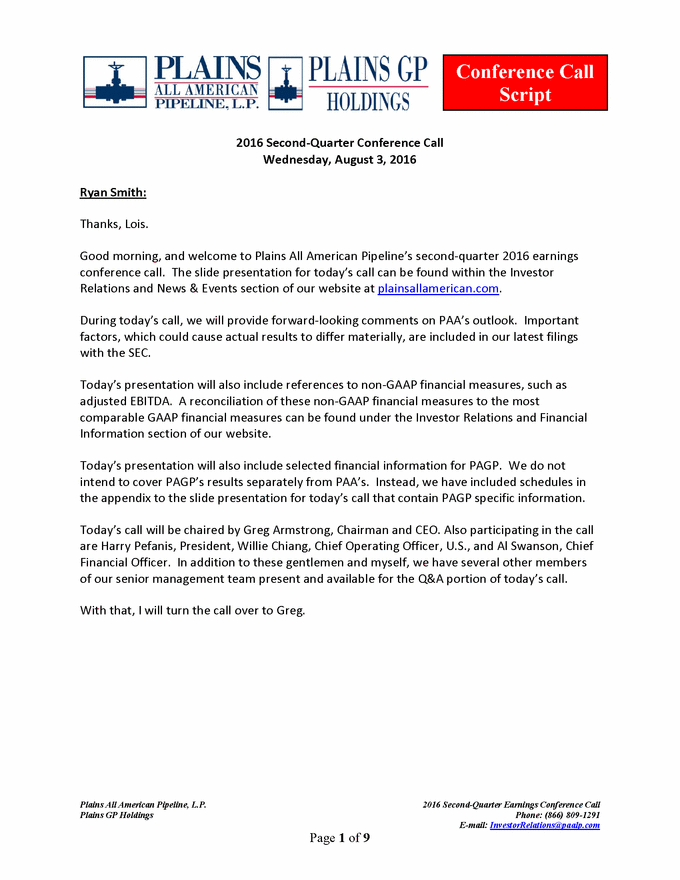
Greg Armstrong: Thanks, Ryan. Good morning and thank you for joining us. We have been very active since our first quarter earnings conference call that was held in early May. Accordingly, before we discuss second quarter results, I want to quickly recap our activities over the last three months. On May 25th we hosted our annual Investor Day event where we provided an in depth review of PAA’s assets, operations and positioning for the future. We also shared our views on some of the challenges and opportunities associated with three alternative production forecast scenarios. In particular, we provided detailed regional information on what we referred to as Scenario B, which we currently believe represents the highest probability among the three alternative scenarios. On July 11th we announced the results of our simplification process between PAA and its general partner related entities, which included entering into a definitive agreement to permanently eliminate PAA's incentive distribution rights and economic rights associated with PAA's 2% general partner interest in exchange for 245.5 million units of PAA and the assumption by PAA of AAP’s outstanding debt, which is currently approximately $600 million. At the same time, we also announced that PAA’s and PAGP’s second quarter distribution payable in August would remain at the same level as the first quarter distribution paid in May; however, effective with the third quarter distribution payable in November, PAA announced that it intends to reset its distribution to $0.55 per unit or $2.20 per unit annualized. That equates to a 21% reduction. The net impact on PAGP of the simplification transaction and PAA’s distribution reduction would equate to a corresponding decrease in PAGP’s quarterly distribution of approximately 11%. Collectively, we believe these actions will better align the interests of PAA’s equity holders, improve its overall credit profile, reduce its cost of incremental capital and improve its distribution coverage. As Harry and Willie will address during their remarks, over the last three months we’ve also been executing our 2016 capital program and making progress with respect to both asset sales and an asset acquisition. In short, the entire Plains team has been extremely busy and Plains All American Pipeline, L.P. Plains GP Holdings 2016 Second-Quarter Earnings Conference Call Phone: (866) 809-1291 E-mail: [email protected] Page 2 of 9
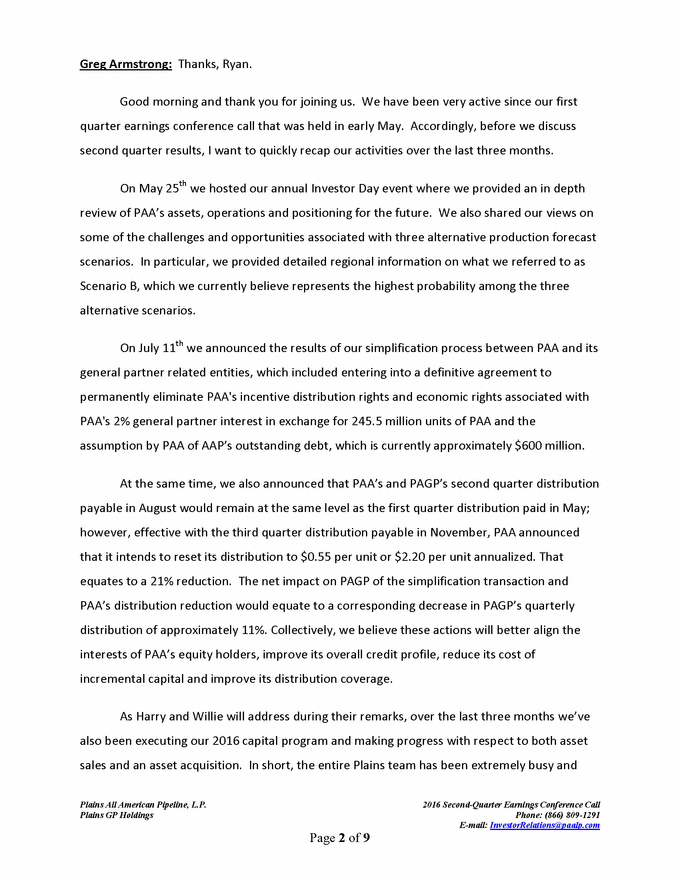
productive and I wanted to take this opportunity to publicly thank them for their commitment, performance and the personal sacrifices they made to deliver these accomplishments. In addition to all of the other activities, PAA continued to execute well operationally and commercially in a challenging environment. Yesterday evening, PAA reported adjusted EBITDA of $461 million, which was approximately $21 million, or 5% above the midpoint of our second quarter guidance. Harry will provide additional details during his comments, but as shown on slide 3, all three segments turned in solid performance as both the Transportation and Facilities segments delivered results slightly above the high end of our second quarter guidance range, while the Supply and Logistics segment delivered in-line performance. Crude oil prices rallied in late May and in early June leading to a rebound in the crude oil rig count consistent with the assumptions we incorporated in the Scenario B production forecast presented during our Investor Day. Thus far, it appears lower 48 onshore production volumes are directionally tracking this Scenario B production forecast. While we are encouraged by these developments, we remain cautious over the near term based on stubbornly high crude oil inventory levels, recent builds in total product inventories and continued intense competition for the marginal barrel. Accordingly, although PAA outperformed in the second quarter relative to guidance, taking all of the information available to us into consideration, we elected to maintain the midpoint of our full year adjusted EBITDA guidance at $2.175 billion. Notably, based on this guidance and taking into consideration both the simplification transaction and the distribution reset to $2.20 per unit, PAA’s pro forma cash distribution coverage for the second half and full year of 2016 is expected to be approximately 1.03x and 1.05x, respectively. Looking forward, we expect PAA’s Adjusted EBITDA to benefit from increases in minimum volume commitments on existing assets as well as numerous capital projects scheduled to come on line over the next 18 months. In combination with PAA’s large interconnected crude midstream platform and the significant operating leverage it provides to a sustained increase in U.S. crude oil production, we believe PAA is well positioned to achieve Plains All American Pipeline, L.P. Plains GP Holdings 2016 Second-Quarter Earnings Conference Call Phone: (866) 809-1291 E-mail: [email protected] Page 3 of 9
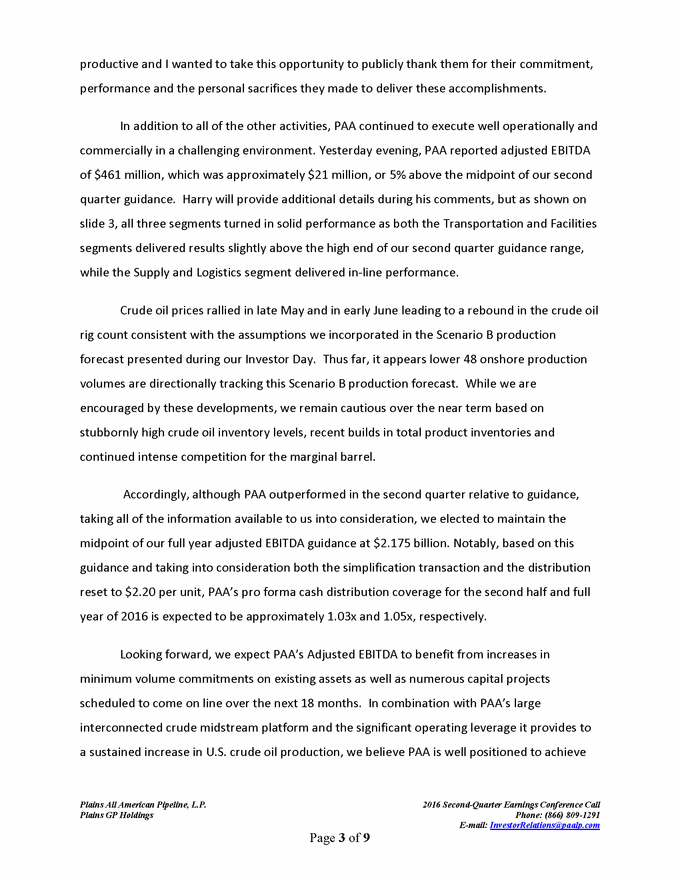
its targeted minimum distribution coverage of 1.15x and to deliver attractive distribution growth in the coming years. With that I will turn the call over to Harry. Harry Pefanis: Thanks, Greg. During my portion of the call, I’ll review our second quarter operating results compared to the midpoint of our guidance and provide an update on our 2016 capital program. Slide 4 provides a summary of our second quarter 2016 results. As reflected on slide 4, adjusted segment profit for the Transportation segment was $261 million, or approximately $9 million above the midpoint of our guidance. For the quarter, volumes were in-line with our guidance at approximately 4.78 million barrels per day. Adjusted segment profit of $0.60 per barrel was $0.02 per barrel above the midpoint of our guidance. And, this was driven by higher than forecasted volumes on some of our higher tariff pipelines, particularly Line 2000 in California and our Canadian NGL lines. The increased volumes on Line 2000 were primarily due to a third party pipeline that was temporarily shut down during the quarter. I should also note that the volume impact of the sale of certain of our Gulf Coast pipelines at the end of March was offset by our acquisition of the remaining interest in the CAM pipeline system in late March. We then sold 100% of the CAM pipeline on July 1st. And, Willie will touch on the impact this sale will have on our third quarter volume assumptions later. Adjusted segment profit for the Facilities segment was $161 million, which was approximately $13 million above the mid-point of our guidance. Volumes of approximately 128 million barrels of oil equivalent per month were essentially in-line with our guidance. Adjusted segment profit of $0.42 per barrel was $0.04 per barrel above the midpoint of our guidance due to a combination of higher than forecasted throughput at several of our facilities, and contracted capacity at a couple of our West Coast terminals was higher than expected. In addition, our maintenance and integrity expenses were lower than forecasted, and for the most part this is a timing issue with the costs expected to be incurred later in the year. Plains All American Pipeline, L.P. Plains GP Holdings 2016 Second-Quarter Earnings Conference Call Phone: (866) 809-1291 E-mail: [email protected] Page 4 of 9
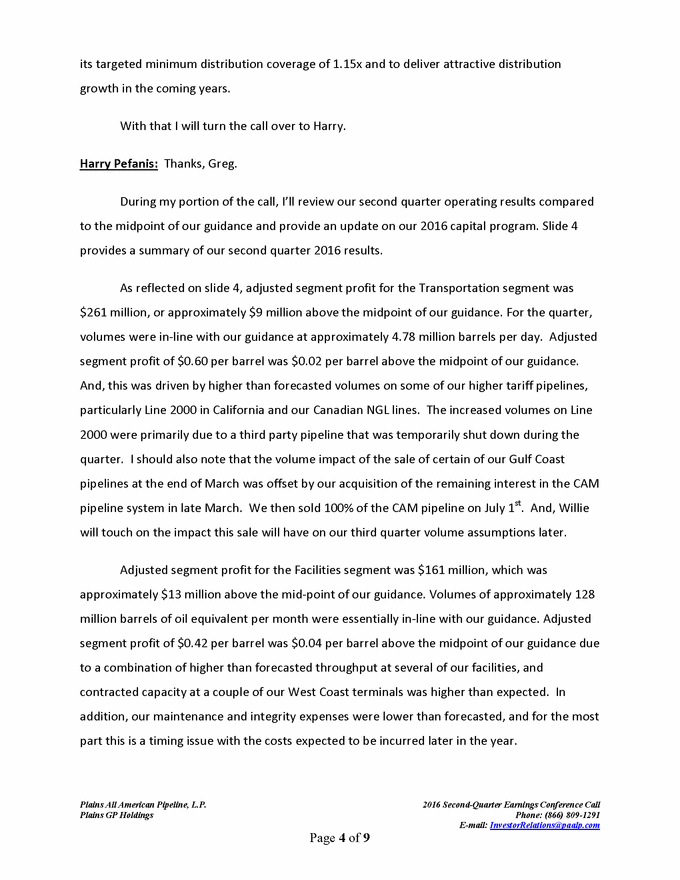
Adjusted segment profit for the Supply and Logistics segment was $39 million, which was essentially in-line with the midpoint of our guidance. Volumes of approximately 1.07 million barrels per day and adjusted segment profit per barrel of $0.41 were also essentially in-line with our guidance as well. Moving on to our capital program, slide 5 provides a summary of our 2016 capital program including anticipated in-service dates for each project. We have reduced our anticipated 2016 capital program by $75 million to $1.425 billion primarily as a result of anticipated Diamond spending getting pushed into 2017. I’ll also note that in August we plan to place the segment of our Line 63 system that runs from the San Joaquin Valley to Los Angeles back into service and also the Platteville, Colorado to Cushing, Oklahoma segment of the Saddlehorn pipeline will be placed into service in August. The Carr to Platteville, Colorado segment of the Saddlehorn pipeline is expected to be complete by the end of this year. And with that, I will turn the call over to Willie. Willie Chiang: Thanks Harry. During my part of the call, I’ll provide a brief update on non-core asset sales and discuss our operating and financial guidance for the third-quarter and full-year 2016. As summarized on slide 6, we forecast proceeds near the high end of our $500 to $600 million range for 2016 non-core asset sales, but I’ll note that this does not include proceeds from the potential sale of our West Coast Richmond and Martinez terminals, which is currently in the marketing stage. Since our first quarter earnings conference call, we’ve closed on transactions for total net sales proceeds of approximately $130 million; this includes the sale of our 50% interest in Cheyenne Pipeline LLC to Holly Energy Partners, a strategic partner, and the sale of the Gulf Coast CAM pipeline system. This brings our year-to-date net sales proceeds to approximately $480 million. We anticipate closing additional transactions, both non-core asset sales and potential sales of partial interests to strategic partners, later this year. Finally, we Plains All American Pipeline, L.P. Plains GP Holdings 2016 Second-Quarter Earnings Conference Call Phone: (866) 809-1291 E-mail: [email protected] Page 5 of 9
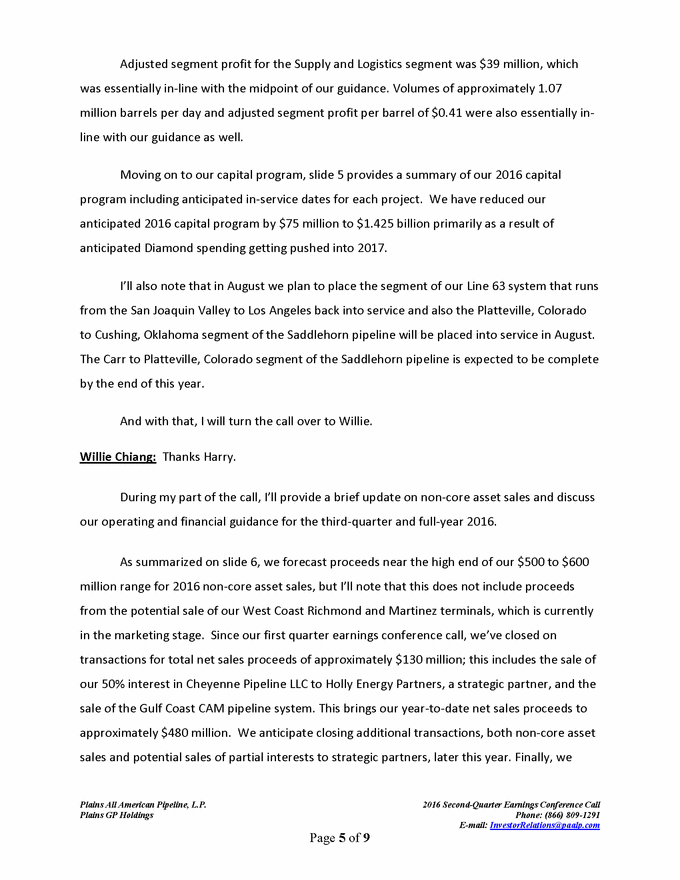
have satisfied the regulatory closing conditions for our acquisition of Canadian NGL assets at Empress and are scheduled to close within the next week or so. I might add that the volumes related to the assets we have sold to date were approximately 190,000 barrels per day of pipeline transportation volumes and 4 million barrels of storage capacity. I am now going to move on to slide 7 to discuss the operational assumptions used to generate our guidance for third-quarter 2016, which we furnished yesterday. For our Transportation segment, we expect volumes to average approximately 4.6 million barrels per day for the third quarter, or a decrease of approximately 150,000 barrels per day from the second quarter. I want to highlight that we expect approximately 40,000 barrels per day of additional volume growth in our gathering systems, primarily in the Permian and Oklahoma, which is being offset by approximately 175,000 barrels per day of lower margin volumes from the sale of the Gulf Coast CAM pipeline and an expected shortfall in MVC volumes. On the margin side, we expect adjusted segment profit per barrel to be $0.68, or $0.08 per barrel higher than the second quarter. This is primarily due to anticipated MVC billings and the resulting selected item adjustments that we anticipate for the third quarter. For our Facilities segment, we expect an average capacity of 130 million barrels of oil equivalent per month, or an increase of approximately 2 million barrels per month from the second quarter. The volume increase is primarily the result of our acquisition of NGL storage and fractionation capacity at Empress, in addition to new crude oil tankage at our Cushing and St. James terminals. We expect adjusted segment profit per barrel to be $0.38, or $0.04 per barrel lower than the second quarter. The decrease in segment profit per barrel is attributed to higher operating expenses, primarily due to timing of maintenance and integrity expenses, lower rail volumes, and a more normalized storage market forecasted for our West Coast terminals partially offset by the benefit of the Canadian NGL acquisition. For our Supply and Logistics segment, we expect volumes to average 1.1 million barrels per day, or an increase of approximately 24,000 barrels per day from the second quarter. The anticipated volume increase is primarily driven by an anticipated increase in U.S. crude oil lease Plains All American Pipeline, L.P. Plains GP Holdings 2016 Second-Quarter Earnings Conference Call Phone: (866) 809-1291 E-mail: [email protected] Page 6 of 9
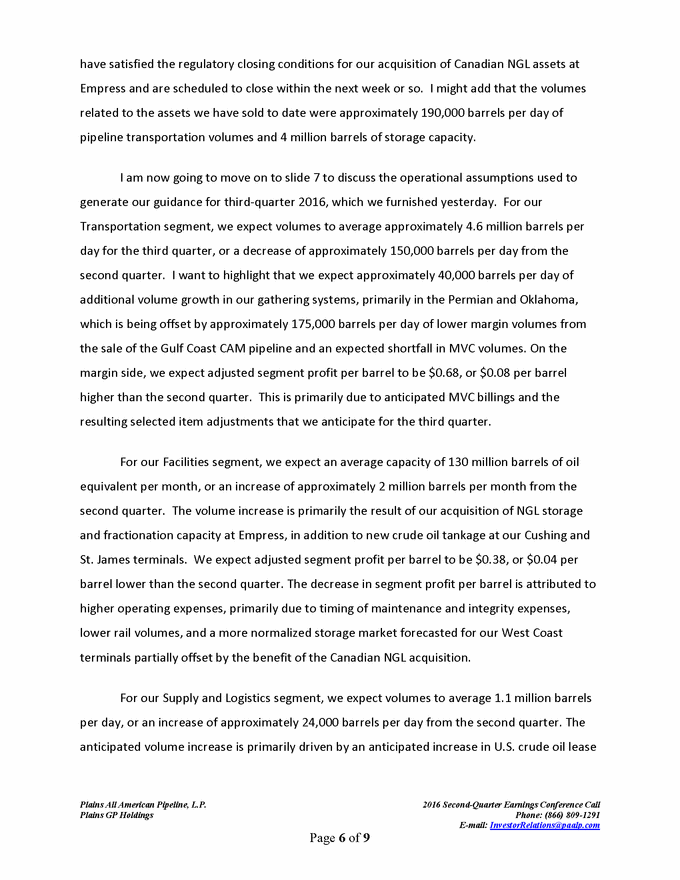
gathering volumes. We expect adjusted segment profit per barrel to be $0.37, or $0.04 per barrel lower than the second quarter due to lower lease gathering margins and less favorable crude oil conditions, partially offset by stronger expected NGL sales results. Finally, as Greg mentioned previously and as summarized on slide 8, we continue to forecast full year 2016 midpoint adjusted EBITDA of $2.175 billion. On the right hand section of the slide is a directional illustration that serves as a reminder that our full year adjusted EBITDA profile is “U” shaped in nature due to the inherent seasonality of our NGL business. Although this generally has a negative impact on our distribution coverage ratio in the second and third quarter, this is expected and consistent with the guidance we furnished in May. For more detailed information on our 2016 guidance, please refer to the Form 8-K furnished yesterday. With that, I’ll turn the call over to Al. Swanson: Thanks, Willie. During my portion of the call, I will review our capitalization and liquidity as well as discuss several non-cash charges that impacted our second quarter financial performance. As illustrated on slide 9, at June 30, 2016, PAA had a long-term debt-to-capitalization ratio of 51%, a long-term debt-to-adjusted EBITDA ratio of 4.4x and $2.9 billion of committed liquidity. While our long-term debt-to-adjusted EBITDA ratio is elevated relative to historic levels and our targeted range, we remain committed to reducing this leverage ratio and expect to return to the targeted range over time as we benefit from capital projects coming on line, as well as from proceeds from asset sales, retained cash flow as a result of the intended distribution reset, and from meaningful cash flow growth that will come with an industry recovery. Additionally, with the disproportionate burden of the GP IDRs removed as a result of our simplification, PAA’s incremental cost of equity capital is significantly reduced. Accordingly, with cost effective access to the equity market, including through the use of our continuous Plains All American Pipeline, L.P. Plains GP Holdings 2016 Second-Quarter Earnings Conference Call Phone: (866) 809-1291 E-mail: [email protected] Page 7 of 9
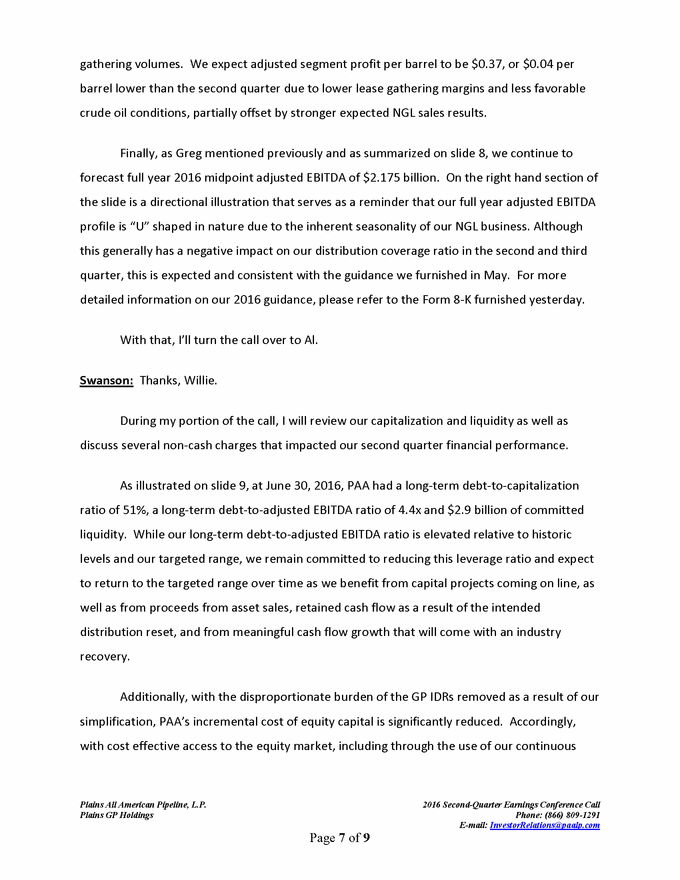
equity offering program, we believe that the public equity markets will again be an effective source of capital for PAA to fund growth investments as well as a tool to help manage our capital structure and leverage from time to time. Additionally, the combination of the simplification and distribution reset reduces annual cash distributions by approximately $320 million per year which has a meaningful benefit to cash distribution coverage resulting in pro forma 2016 coverage of approximately 105%. I also wanted to mention that in the guidance 8-K that we furnished yesterday, we assumed that the simplification transaction closed in early November. We are currently working on the proxy statement and expect to make an initial filing with the SEC within the next week or so. Lastly, depreciation and amortization expense for the second quarter is $204 million and includes several non-cash charges related to assets included in our Facilities Segment. As a result of current crude oil industry conditions and reduced business activity, we recorded an impairment charge totaling $80 million on two crude oil rail loading terminals and on a small storage terminal that is being shut down. In addition, we recognized a charge of $18 million to write-off the book value of a non-operated joint venture straddle gas plant that is being decommissioned. With that, I’ll turn the call back over to Greg. Armstrong: Thanks Al. We are pleased with PAA’s second quarter performance and believe we are well positioned for the balance of the year and beyond. PAA has one of the largest and most interconnected crude oil midstream platforms in North America, which has significant leverage to a sustained increase in U.S. crude oil production with no-to-low incremental capital investment. PAA has $2.9 billion of committed liquidity and our performance is expected to benefit from increases in minimum volume commitments on existing assets as well as numerous capital projects scheduled to come on line over the next 18 months. Plains All American Pipeline, L.P. Plains GP Holdings 2016 Second-Quarter Earnings Conference Call Phone: (866) 809-1291 E-mail: [email protected] Page 8 of 9
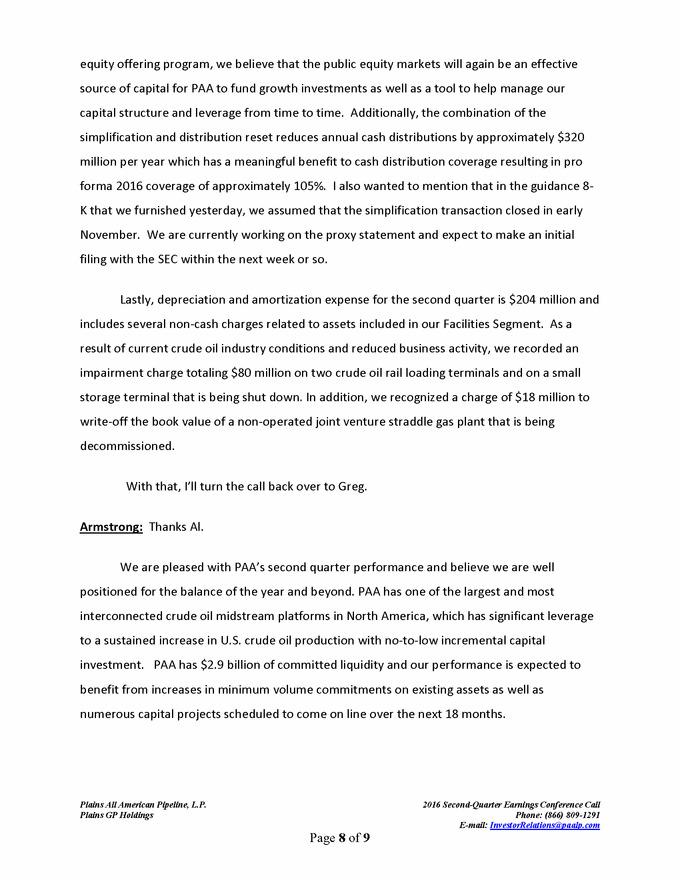
I want to thank everybody for participating in today’s call and for your investment in PAA and PAGP. We look forward to updating you on our activities during our third quarter call in November. And with that, Lois, we are now ready to open up the call for questions. Plains All American Pipeline, L.P. Plains GP Holdings 2016 Second-Quarter Earnings Conference Call Phone: (866) 809-1291 E-mail: [email protected] Page 9 of 9
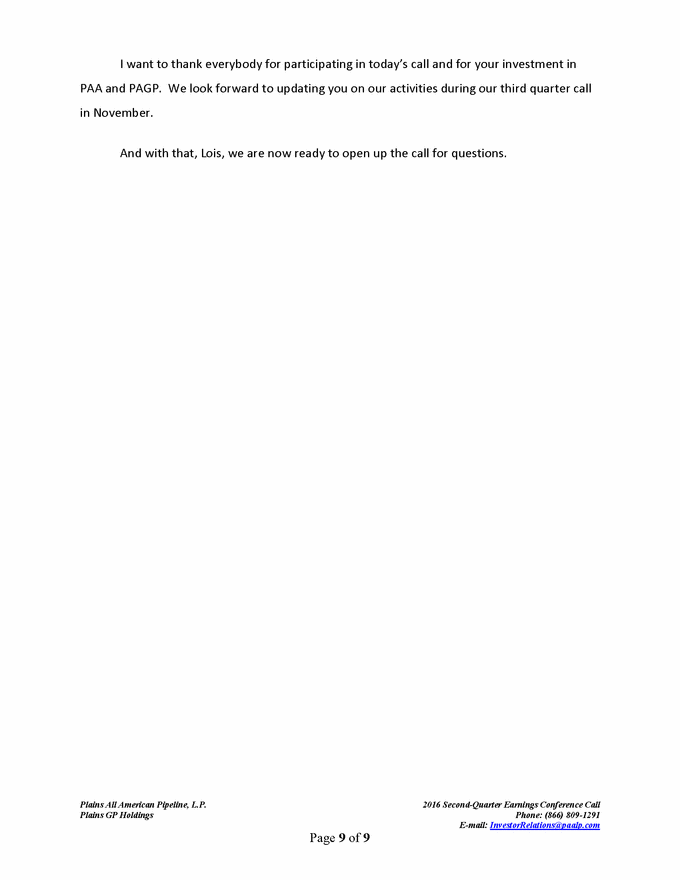
Company Name: Plains All American Pipe Company Ticker: PAA US Date: 2016-08-03 Event Description: Q2 2016 Earnings Call Market Cap: 10,945.71 Current PX: 27.52 YTD Change($): +4.42 YTD Change(%): +19.134 Bloomberg Estimates - EPS Current Quarter: 0.344 Current Year: 1.463 Bloomberg Estimates - Sales Current Quarter: 5793.500 Current Year: 22387.778 Thanks, Willy. During my portion of the call, I will review our capitalization and liquidity as well as discuss several non-cash charges that impacted our second quarter financial performance. As illustrated on slide 9, at June 30, PAA had long-term debt to capitalization ratio of 51%, a long-term debt to adjusted EBITDA ratio of 4.4 times and $2.9 billion of committed liquidity. While our long-term debt to adjusted EBITDA ratio is elevated relative to historic levels and our targeted range. We remain committed to reducing this leverage ratio and expect to return to the targeted range over time, as we benefit from capital projects coming on line as well as from proceeds from asset sales, retain cash flow as a result of the intended distribution reset and from meaningful cash flow growth that will come from an industry recovery. Additionally, with the disproportionate burden of the GP IDRs removed as a result of the simplification, PAA's incremental cost of equity capital is significantly reduced. Accordingly, with cost effective access to the equity market, including through the use of our continuous equity offering program, we believe that the public equity markets will again be an effective source of capital for PAA to fund growth investments as well as a tool to help manage our capital structure and leverage from time-to-time. Additionally, the combination of the simplification and distribution reset reduces annual cash distributions by approximately $320 million per year, which has a meaningful benefit to cash distribution coverage resulting in pro forma 2016 coverage of approximately 105%. I also wanted to mention that in the guidance 8-K that we furnished yesterday, we assume that the simplification transaction closed in early November. We are currently working on the proxy statement and expect to make an initial filing with the SEC within the next week or so. Lastly, depreciation and amortization expense for the second quarter is $204 million and include several non-cash charges related to assets included in our Facilities segment. As a result of current crude oil industry conditions, and reduce business activity, we recorded an impairment charge totaling $80 million on two crude oil rail loading terminals and on a small storage terminal that has been shutdown. In addition, we recognized the charge of $18 million to write-off the book value of a non-operated joint venture [indiscernible] gas plant that is being decommissioned. With that, I'll turn the call back over to Greg. Greg L. Armstrong Thanks, Al. We are pleased with PAA's second quarter performance and believe we're well positioned for the balance of the year and beyond. PAA has one of the largest and most interconnected crude oil midstream platforms in North America, which has significant leverage to sustain increase in U.S. crude oil production with no to low incremental capital investment. PAA has $2.9 billion of committed liquidity and our performance is expected to benefit from increases in minimum volume commitments on existing assets as well as numerous capital projects schedule to come online over the next 18 months. I want to thank everybody for participating in today's call and for you investment and trust in PAA and PAGP. We look forward to updating you on our activities through our next call in November. With that, [indiscernible] we're ready to open to call up for questions. Q&A Operator Thank you. [Operator Instructions] And our first question will come from Kristina Kazarian with Deutsche Bank. Go ahead, please. <Q - Kristina Kazarian>: Good afternoon, guys. I know you guys touched on this in your comments, and it was in the press release a little bit too. But can you help me just think me up on, what you guys are seeing regional volume trends like kind of in system relative to, where we're thinking towards the year-end expectations, particularly Eagle Ford looks Page 5 of 14
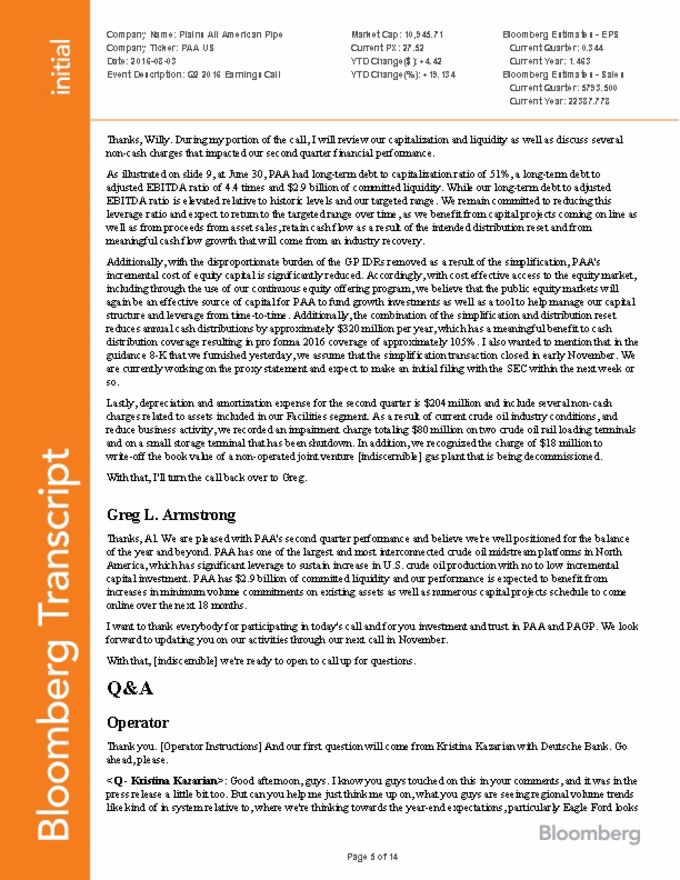
Company Name: Plains All American Pipe Company Ticker: PAA US Date: 2016-08-03 Event Description: Q2 2016 Earnings Call Market Cap: 10,945.71 Current PX: 27.52 YTD Change($): +4.42 YTD Change(%): +19.134 Bloomberg Estimates - EPS Current Quarter: 0.344 Current Year: 1.463 Bloomberg Estimates - Sales Current Quarter: 5793.500 Current Year: 22387.778 okay, Rocky Mountain weak, Gulf Coast above kind of those numbers. Just specifically on those three regions, what we're kind of thinking? <A>: I think all of that – in all three areas, our volumes are in line with what we had – that we had modeled in our – I think, we're seeing that, I guess, you've kind of asked more of a macro what are we seeing relative to what we expected to see? <Q - Kristina Kazarian>: Yes. <A>: Yeah. And pretty much, we're tracking kind of, where we thought we were and kind of our Scenario B, the one area that appears to be the most resilient, if not actually kind of over perform [indiscernible] a little bit is in the Permian. The overall activity levels are generally in line with what we thought, the results from the wells that are being reported are stronger. And so, that's an area, where clearly, we have our biggest footprint, and we're not ready to declare actually a victory on that, but we're certainly looking at with cautious optimism. <Q>: Okay. And then how about product again [indiscernible] from the asset sale program or additional interest in other projects, I know you guys touched on this as well, but any color on timeframe or thought process there. <A - Willie Chiang>: Yeah. So we've got, as I noted, – this is Willie, as I've noted in my narrative, we've got a number of deals that we expect to complete by year-end. And I think what you'll see is they're going to be consistent with other projects we've done, where we've taken our strategic partners like the sale of Cheyenne Pipeline, part of the Cheyenne Pipeline to HollyFrontier or Saddlehorn, you'll see some of that, and then we also have some additional non-core assets that we're evaluating, but probably the biggest thing that's in progress right now, Kristina, is the West Coast terminals, Richmond and [ph] Martin as well. So we've been very pleased with the values we're getting and the progress that we're making. <A>: I might just add, Kristina, I think about a year ago, we made the observation that is we entered this, get further into the cycle that we thought there'd be a need for rationalization assets and we thought there might be some consolidation. We've been rolling the consolidation so far, but the rationalization by assets, not only are we doing it, as Willie mentioned, we've got a couple of joint ventures we've announced. We've got a few more that, that we're working on, we're kind of knocking on would to see if they move forward. But and I think some announcements here recently reinforce that everybody is trying to figure out how do you rationalize the existing capacity and also rationalize the expansion that's being going on and in the mid-core. So I think we'll continue to see some of that, and PAA is well positioned because we're in just about every area there. So, we're looking hard at it, we think the industry in the whole – it's not unique to us, everybody is looking at trying to figure out, how do you get more out of this. <Q>: Okay. And last one from me, when I'm thinking about the projects that are coming online in the back half of this year. Just remind me [indiscernible] we're thinking about cash flow ramp on things like Cactus? <A>: At Cactus I think the volume increases are expected to be actually next year. <Q>: Comes online – sorry comes online 4Q 2016 rate. So, just how do I think about cash flow ramp once it's online, I don't think I got that wrong? <A>: Yeah. There is two things, I think number one we've got expansion to be able to handle incremental volume, that's going to happen right around the beginning of the first – fourth quarter. We have a MVC step up, one of which the largest is tied to the third parties expanding their project and right now we would estimate that's going to be probably end of the year, first part of next year. So, you should start to see it when we report first quarter results. <Q>: Thanks, guys. <A>: Thank you. Operator Page 6 of 14
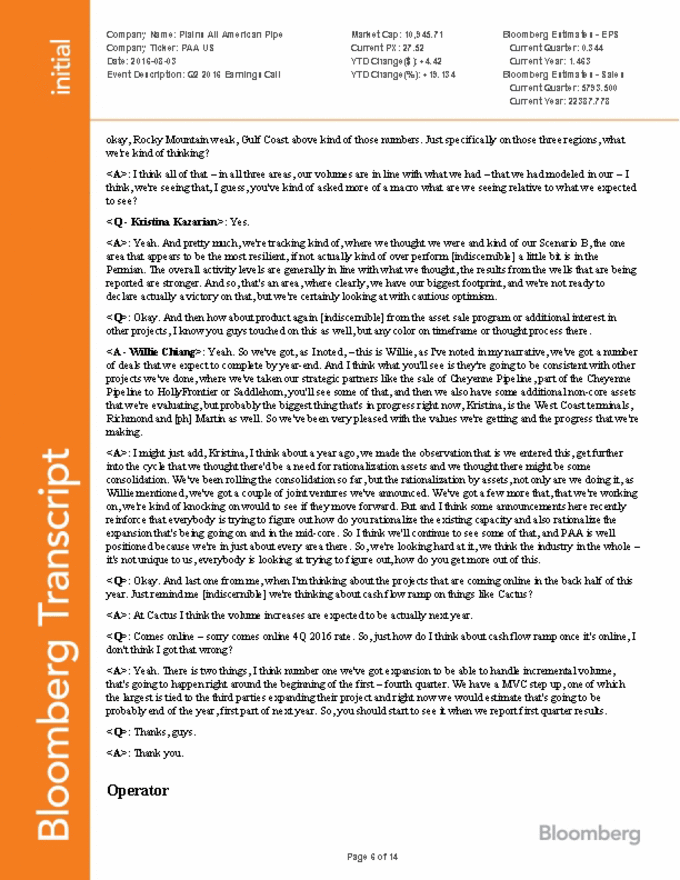
Company Name: Plains All American Pipe Company Ticker: PAA US Date: 2016-08-03 Event Description: Q2 2016 Earnings Call Market Cap: 10,945.71 Current PX: 27.52 YTD Change($): +4.42 YTD Change(%): +19.134 Bloomberg Estimates - EPS Current Quarter: 0.344 Current Year: 1.463 Bloomberg Estimates - Sales Current Quarter: 5793.500 Current Year: 22387.778 Thank you. Our next question will come from Shneur Gershuni with UBS. Go ahead please. <Q - Shneur Gershuni>: Hi. Good morning, guys. Just a couple of quick questions here. I guess when I sort of think – look at the slides that you put out and looking at slide five you talk about your major capital projects that you have coming forward, and I look at every single one of them and it says, yes, under MVC contractual support. I was wondering if you can sort of give us a sense of the incremental EBITDA by 4Q 2017 that is sort of generated just by the MVCs for all of these projects relatively speaking to kind of where you were at the beginning of 2016? <A>: Shneur, I don't have that right in front. I think the best source of that would be in the Analyst Day presentation. Alan had a slide in his section, that showed – I don't know that it's actually going to get you to just the fourth quarter, I think it's kind of a full run rate as all these projects come on, but you can kind of visually scale it by looking at the dates that the end service timings come on with the target level there – came in reality. <A>: Order magnitude it was – I think the slide was just over $200 million of which a good portion of that, I'll say two-thirds of it, roughly a $150 million was in 2017 and then the remaining piece was the Diamond Pipeline startup at the end of 2017 for 2018. <A>: And that was a component of these projects, not everyone. <A>: Right. <Q>: Okay. Thank you. And then as a follow-up, actually I have two follow-ups, but the ethanol segment, there has kind been a lot of questions about when spreads will recover, what you're thinking about in terms of spreads recovering to sort of get to kind of the $500 million or plus promised land. And I did – I realized it's difficult to express it in hubs, which hubs should move and so forth. I was wondering maybe if we can think about it a different way, when you think about domestic crude production, both offshore, onshore, what production level do we need to get to, to generate a scenario where spreads do expand to create the opportunities? I'm not saying it has to go up to the crazy spreads we saw a couple of years ago, but do we need to get back to $9 million, do we need to get to $9.3 million, $9.4 million? Is there kind of a number that we should sort of be thinking that as to when you would be thinking about an expansion in spreads that would benefit the ethanol segment? <A>: Well, I think it's going to be more regional than that. I don't know that you think of it in the aggregate. First off, we don't include Alaska in anything that we talk about and we really don't include the offshore, so we're really talking about lower 48. And as a practical matter, we're talking about really lower 47 because California has Cayman Island into itself. So, it varies by area. I think the other thing that you need to include in the – your thoughts as to what volumes need to be raised or levels need to be achieved, is part of it is associated with the spreads or tight in certain areas, because of the MVCs and the over-commitments that we have and so there are people that have a short – have their long transportation, but their short barrels. And so, they are competing for those incremental barrels to try and minimize their transportation cost, as certain of those contracts expire or get reformatted, that will be a surrogate if you will for volume increases. And – so a part of it is just the function of volumes as you suggest and part of it's a function of the regional balances, and that's going to change with the passage of time, in some cases, 100,000 barrels can have a fairly potential significant increment to the margin relief on the competition side. <Q>: Okay. And then one final question, when we looked at your Analyst Day slides, and you sort of look at your Permian production outlook, while it is upward sloping, it was very conservative relative to lot of industry pandits out there and so forth. Recently, I believe it was Pioneer had sort of talked about an opportunity to get to 5 million barrels, which would basically double current Permian capacity in terms of takeaway. How do you think it actually plays itself out, do you actually see opportunities or scenarios where you would actually need to build more takeaway capacity as a Permian. Also are more basins further north effectively looking to connect capacity to the Permian to sort of take advantage of the capacity, as it gets to the Gulf and Nederland and so forth. So, wondering if you can sort of talk about that, in those context? Page 7 of 14
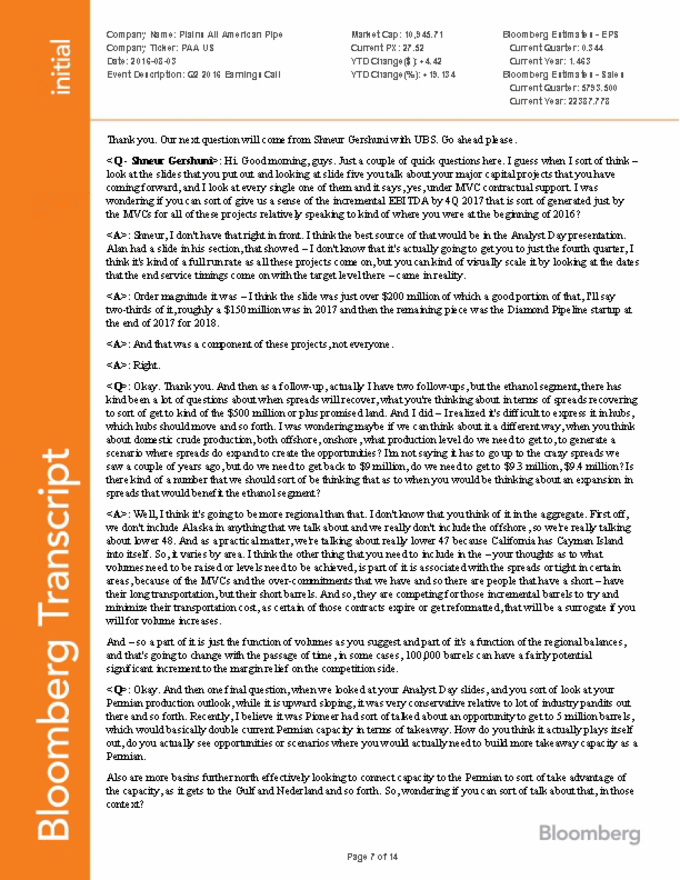
Company Name: Plains All American Pipe Company Ticker: PAA US Date: 2016-08-03 Event Description: Q2 2016 Earnings Call Market Cap: 10,945.71 Current PX: 27.52 YTD Change($): +4.42 YTD Change(%): +19.134 Bloomberg Estimates - EPS Current Quarter: 0.344 Current Year: 1.463 Bloomberg Estimates - Sales Current Quarter: 5793.500 Current Year: 22387.778 <A>: Yeah. First topic is the question whether we need 5 million barrels a day as a Permian is more a function of a macro issue that none of us are in control of, it's more of a world supply, demand balance. I think what we are all willing to sign off on is, there is a huge amount of resource out there and there is – you can certainly create a scenario that if there is worldwide demand for the crude, you could actually achieve very, very high levels of production out of the Permian. I don't recall exactly what Pioneer's date did they put on that 5 million barrels, I don't think there was one. But clearly, you step on the accelerator, you take your foot off the accelerator, you're going to change those volumes quite a bit. So, part of it is just going be, we're all going to have to monitor the demand for – in the world for crude oil in general and if the answer is we're the swing producer, the Permian is the best place to get it. What we feel pretty good about is, if you recall the upside scenario that we shared at the Analyst Day, I think Willie went through about half of the pipeline upside was associated with the Permian. So, if you believe it's going to get anywhere north of 3 million barrels, much less 5 million barrels, every pipe out there is going to be full and we're all going to be talking about a need for expansion or new pipelines. I think the reality is there is probably enough expansion of the existing pipelines, probably you will remain to hearing really 2,000 barrels a day or 3,000 barrels a day by adding new pumps or incremental DRA. So, you don't necessary need a new piece of pipe to handle 2.8 million barrels a day to 3 million barrels a day, but you clearly do if you get on up to the numbers you're talking about and we're at like 2 million barrels a day at the Permian right now. So, 3 million barrels a day requires another million barrels a day of volume. <Q>: In sort of like – when you sort of look at the map, do you see scenarios where other basins look to solve any tightness that they have in terms of getting production out, to sort of effectively bringing production into the Permian to take advantage of the expansive network that already gets you to the Gulf, do you kind of see that is kind of a source of incremental volumes that can effectively use those pipes as well too? <A - Willie C. W. Chiang>: I don't think so. This is Willie. There's a lot of capacity from Cushing down and I think if you believe the numbers that you're talking about on the Permian, I think barrels would continue to flow out of the Permian, because I think there has been enough infrastructure that's been built that allows it to get to the Gulf with the exception perhaps of the Eastern Gulf, the Louisiana refineries. <A>: Yeah. I think what we've seen so far Shneur is that – what you really wanted is, you want to get to a market hub and Cushing is far and away, the most liquid. Obviously we're building pipelines out of there both Red River going to East Texas and Louisiana and then one to across the Memphis on Diamond. So right now I don't feel like there is – anybody is going try and build a pipeline from let's say the Rocky's down to the West Texas to access those barrels, and I think [indiscernible] realizes that at 2.5 million barrels a day a takeaway capacity and there's another pipeline in the [indiscernible] that would be brought on in the next couple of years. If you believe the kind of volumes that I think we're all willing to believe about the Permian, you're going to need the pipeline capacity you have there, so no need to build the pipeline there, jam the area and then wish you had more capacity coming out. Like I always said there is so much infrastructure that [indiscernible] can deliver crude from the Bakken and the Rocky's and et cetera and the Cushing, and there is plenty of takeaway capacity out of Cushing, wouldn't seem to really need to try and tie into the infrastructure in the Permian? <Q>: Right, guys. Really appreciate the color. Thank you very much. <A>: Thank you. Operator Thank you. And our next question comes from Jeremy Tonet with JPMorgan. Please go ahead. <Q - Jeremy B. Tonet>: Good morning. Page 8 of 14
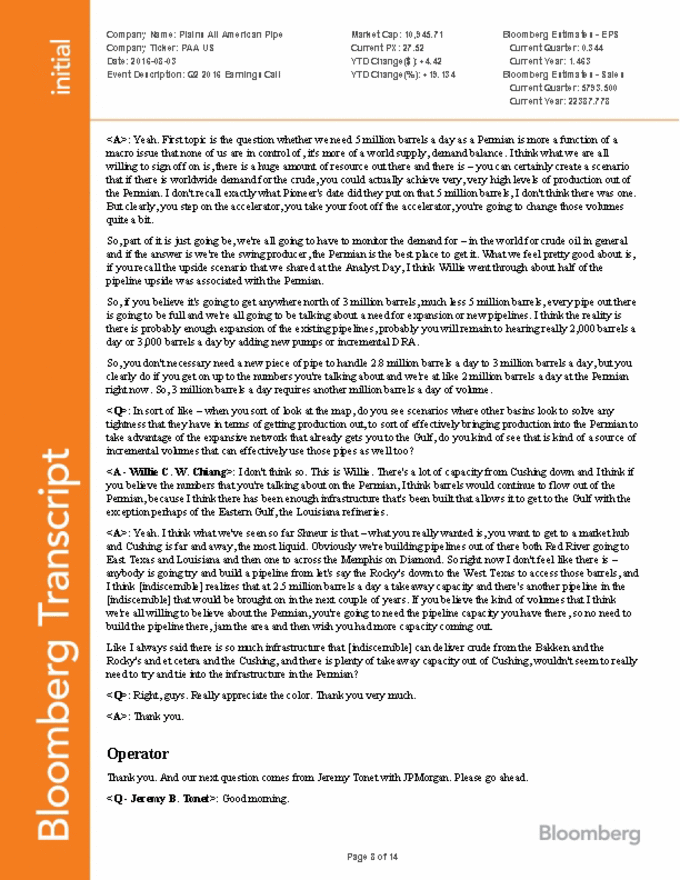
Company Name: Plains All American Pipe Company Ticker: PAA US Date: 2016-08-03 Event Description: Q2 2016 Earnings Call Market Cap: 10,945.71 Current PX: 27.52 YTD Change($): +4.42 YTD Change(%): +19.134 Bloomberg Estimates - EPS Current Quarter: 0.344 Current Year: 1.463 Bloomberg Estimates - Sales Current Quarter: 5793.500 Current Year: 22387.778 <A>: Good morning, Jeremy. <Q - Jeremy B. Tonet>: The facilities segment seems to kind of keep outpacing our expectations a bit here. And I was just wondering if you guys are seeing much benefit on gas storage side, or if there is anything else that's kind of improving be better than expected in that segment? <A>: I think for the most part, it's really just in a lot more activity almost across the board at all the facilities whether it's our condensate processing, our dock at St. James, throughput through Cushing, throughput through St. James, it's all really expanded, and I'll let Dean Liollio, he is sitting here. He could touch on sort of what we see at – with natural gas. <A - Dean Liollio>: Yeah, Jeremy, it's location based, particularly Pine Prairie being the strongest and we're seeing good response, as we previously announced with the new contract there and contracts dim into the future long term. So yeah, we're seeing some uptick particularly at that facility. <A>: I feel all longer term in nature than the current quarter. <A>: Correct. <A>: I think we probably can say we think we got the bottom part of the cycle for gas storage in the rear view mirror, and now we've seen probably uplift of 10% to 20% in rates at the margin, and it's tied a lot to – with respect to gas storage to the commencement of LNG exports and the demand for versatility in your supply stream and the ability to store on short notice and pull out on short notice. <Q>: Great. Thanks for that. And then, turning over to the Pipe segment. Looking at your guidance 3Q into 4Q, there is a bit of a ramp in the volumes there. Could you walk through or give us some color as far as how much of that is kind of MVCs with projects coming on line versus expectations for production growth coming back? <A - Willie C. W. Chiang>: This is Willie again. I would characterize as we got some MVC ramp ups, but we also as we outlined at the Investor Day, we have a pretty significant chase on we called lease gathering at the first purchase barrels to get into the system and we are seeing progress on that as well. <A>: Jeremy, what I would say is our macro production model is assuming continued declines through 2016 and the end of 2017. So, it is not from a industry recovery. <A>: Yes, it's more of a market share issue or project completion issue. <Q - Jeremy B. Tonet>: Okay, great. Thanks. And then, leaves to next more question with regards to rail-off loading, unloading looks like that, they're steps down a bit here, is that MVC rolls over the back half of the year or do you expect less kind of a differential activity? <A>: Part of it is was some of the new pipes coming on, especially at the Rockies and probably impacts rail more than anything, but it's not MVC rail-off. <A>: But at the margin, you're seeing the differentials change or volumes being pulled away to the transport mechanism. <Q - Jeremy B. Tonet>: Great. Thanks. That's it from me. Thank you. <A>: Thanks, Jeremy. Operator Thank you. Our next question comes from Brian Gamble with Simmons & Company. Go ahead please. <Q - Brian D. Gamble>: Hi, guys. <A>: Hi, Brian. Page 9 of 14
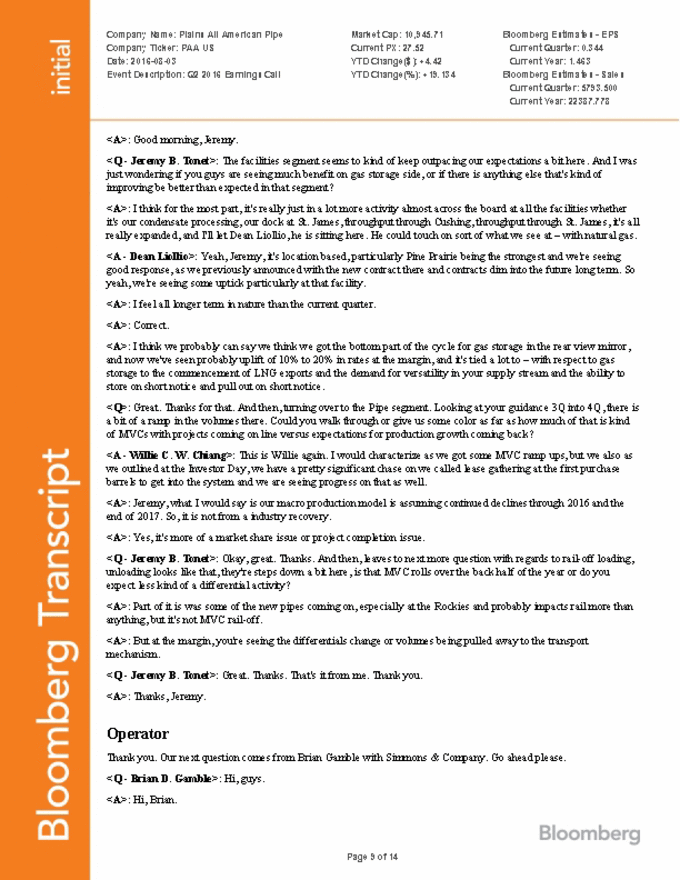
Company Name: Plains All American Pipe Company Ticker: PAA US Date: 2016-08-03 Event Description: Q2 2016 Earnings Call Market Cap: 10,945.71 Current PX: 27.52 YTD Change($): +4.42 YTD Change(%): +19.134 Bloomberg Estimates - EPS Current Quarter: 0.344 Current Year: 1.463 Bloomberg Estimates - Sales Current Quarter: 5793.500 Current Year: 22387.778 <Q - Brian D. Gamble>: To follow on the last thought on the pipeline growth, Greg you walked through at the Analyst Day's [indiscernible] in detail, I think it was there in your remarks you might have been during release, but talking about the opportunity specifically within the Permian to start gaining volumes with some others longer term contracts kind of roll off and because you got the pipes, you can essentially get in there and [indiscernible] preference in your the first barrels come in and maybe some market share gains there. Are you having to sacrifice any – are you having to sacrifice any margin to gain those barrels, I think the indication you gave us earlier was it because, your rates were such, they would allow you to essentially use as same rates moving forward and gain barrels and not necessarily sacrifice any margin. Is that what's happening there or are you just essentially being able to get in there with the extensive opportunity set that you've given producers and gain barrels that way? <A>: No, we're being aggressive at the least. So when we look at the business, because of the integrated system, where the objective function is the integrated margin, not just one section's margin. <A>: Yeah. So to answer your question, you're not having to discount your pipeline tariffs, but you're already sacrificing gathering margin. And again, you can look at it kind of on a consolidated basis to say net-net the company is doing better than they were to lose the barrel, perhaps to somebody is going to take into another pipeline system. And part of this, Brian, is again, it's all influenced by the MVCs, to some extent, because if somebody has got a commitment on the pipeline that has a higher tariff, but they have a ship or pay view on that or contract obligation they're going to view that as a [indiscernible] and the total war on that at the gathering margin. So the producers are benefiting right now from that intense competition. <Q>: Great. I appreciate that color. And then as far as the bump on the ethanol business Q3 to Q4, typical seasonality there. But I guess, given what we're steering at maybe a more hyper-sensitive market than normal specifically NGLs, we saw a pretty decent run up in May and June, the prices and they've come off [indiscernible] since then, I guess, just given what you're operating we'll be seeing now, how much confidence in there the fourth quarter is going to be typically or allow the typical strength that sits there during the calendar year? <A - Harry N. Pefanis>: No, a lot of that NGL volumes contracted for that – it doesn't, a bit seasonal contract. So, we're very confident that over the winter season, we'll generate that NGL seasonal type of revenue. There's always a question of whether you see stronger weather or weaker weather conditions in the fourth quarter versus first quarter. So, there could be some [indiscernible] slip to one way or to the other between fourth quarter and first quarter, but the volumes contracted for. <A>: Yeah, Brian, so we'll have the volumes in our storage and they're committed for to be pulled, but they don't have to pull it, let's say, they can pull it in the third quarter – excuse me fourth quarter or in the first quarter depending upon when they need it for weather balancing. So as Harry said, we're going to capture the margin over let's say a four-months or five-months period, we just don't know, it's in the first three months of the four months, five months or the last couple of months. We feel pretty good about our forecast, obviously if there's a erratic weather pattern, it could shift some of that profit from the fourth quarter to first quarter. But the real seasonal swing that you see there, and you saw it on the graph that or the chart that Willie had, if that's been that pattern for many years and we've had situations in the past, where we've either had margin push from the fourth quarter into the first quarter of the first year – next year or we've had situations, where they've actually pulled it into the fourth quarter and we've had the [indiscernible] you shouldn't get carried away and annualize it. So, we feel pretty good about, I think in the forecast that we have out, it reflects everything than we know as of the time, we put the forecast together. <Q - Brian D. Gamble>: Great. And then last one from me, Greg you mentioned the consolidation really hasn't happened yet, but you got plenty of rationalization, some asset changing hands a big one last night with, I guess on the crude side. But as far as the trends there on the M&A market, anything changing in your view and over the last few months or even since the Analyst Day that has, I guess, prohibited things from happening that may loosen up in the back half of the year, just any color from your perspective would be appreciated. Page 10 of 14
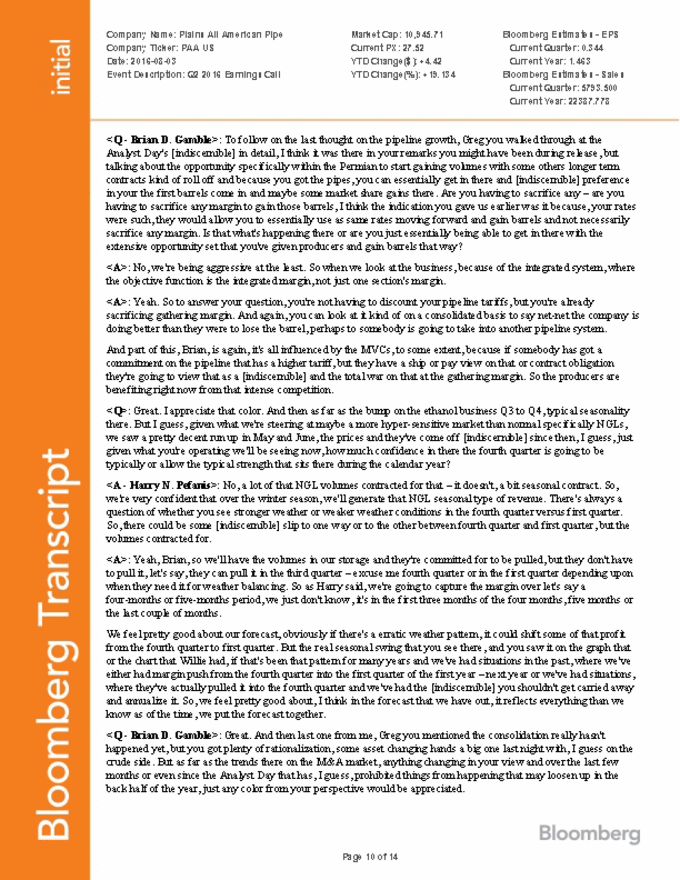
Company Name: Plains All American Pipe Company Ticker: PAA US Date: 2016-08-03 Event Description: Q2 2016 Earnings Call Market Cap: 10,945.71 Current PX: 27.52 YTD Change($): +4.42 YTD Change(%): +19.134 Bloomberg Estimates - EPS Current Quarter: 0.344 Current Year: 1.463 Bloomberg Estimates - Sales Current Quarter: 5793.500 Current Year: 22387.778 <A - Greg L. Armstrong>: Yeah. If you ask me, what area have we been consistently wrong in, it's in projecting the more consolidation, because we see the rational – the reason for it, but it's one of the hardest things to make happen and there is all kinds of issues that get involved in that. I think anytime you end up with a let's call it a head bake or resurgence in the market that makes everybody feel like we're only three months or four months away from everybody pulling out of down cycle, it tends to freeze all discussions. So either we need to pull out of the cycle and then people say, okay, we've now got our relative valuations reset, you probably have an opportunity to have some discussions or alternatively we stay in a lower cycle for longer and people run out of options to be able to either take care of the balance sheet or be able to have a discussion about what growth is going to look like when they come out of the cycle and that kind of forces the discussions. Obviously, the rally that we've had over the last 60 days in crude oil prices probably calls people to pause a little bit and say, why should I even think about it if we're just around the corner from having to pull out of this cycle. So, again, if you go back, I think we had this discussion five years ago, when we said we thought consolidation made a lot of sense. It did, but it didn't happen and we've seen a couple of transactions that are falling apart for other reasons. So we feel comfortable, rationalization is occurring and we think consolidation should occur, whether it does or not remains to be seen. <Q - Brian D. Gamble>: I appreciate that, Greg. That's all from me. <A - Greg L. Armstrong>: Thanks, Brian. Operator Thank you. Our next question is from the line of Richard Verdi from Ladenburg. Please go ahead. <Q>: Hi. Good morning and thank you for taking my call. I just have a few high level type questions, most of my other questions have been addressed in some sort of fashion. On that growth projects, [Technical Difficulty] wondering, what is the company looking at they could push any of the projects out longer or result in any of the projects coming to fruition sooner. And at the same time, wells is out there that could reduce or increase the amount of capital allocated to any of the projects? <A>: The projects are all in progress, it's kind of hard to see much change in the timing of I mean obviously, probably the biggest concern out there would be weather – permitting, especially if you get into some local areas Richard could be a talent but I don't think, you're going to see much in the shift of these projects. I think at the beginning of this year, we said we had about $2 billion of spend left to kind of fulfill the obligations or commitments that we have made, $1.5 billion that coming in 2016 and about $0.5 billion coming in 2017. As this chart shows, we've had some projects come in a little bit under budget and so that's changed, we've also had others that we've changed the scope and so, that's kind offset. The biggest change so far is Diamond, for example. I think it's a permitting issue that we – it's going to cause us to have some of the capital spent next year and fourth quarter of this year. So, don't expect much there. As far as what could change our capital outlook, obviously with the simplification, we've taken a step change in our cost of capital. We think there is certainly some room for, what I call some minor to modest projects out there and mainly to do with plumbing. Some of these areas that are being developed are continuing to creep in terms of broaden their footprint. We think there is enough takeaway capacity in most areas, the service the foreseeable needs. And so all you'd really need to do is the re-planning some of the existing infield infrastructure extending that to be able to get to that takeaway capacity. So but I think we – and I think we're seeing the discipline pretty much throughout most of the industry are commanding in an appropriate way to return to that even though it's still competitive. I don't think the markets are quite as silly as they were, being there and things done in the single-digit returns, which we saw some of that in 2014. Page 11 of 14
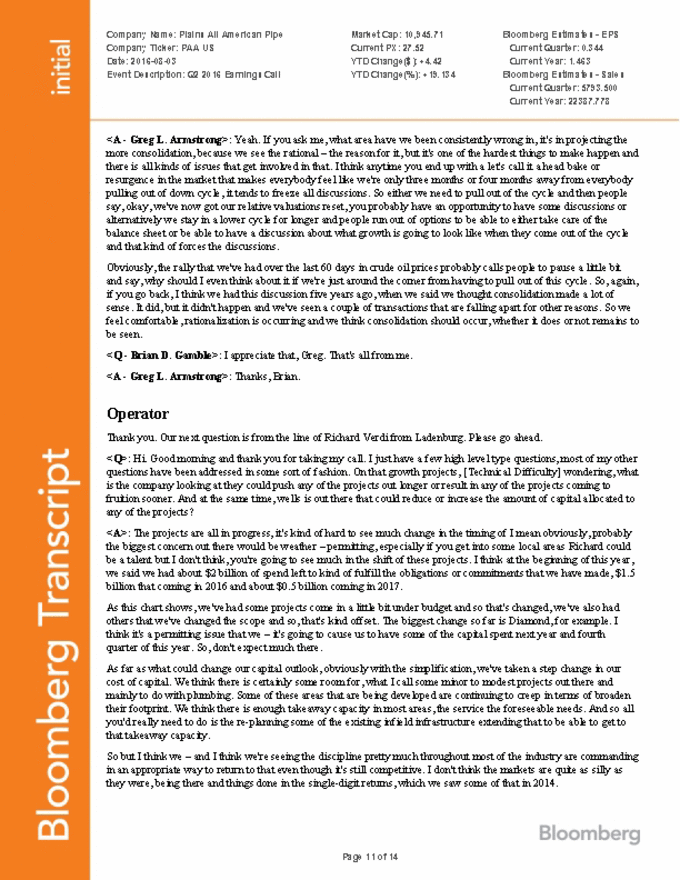
Company Name: Plains All American Pipe Company Ticker: PAA US Date: 2016-08-03 Event Description: Q2 2016 Earnings Call Market Cap: 10,945.71 Current PX: 27.52 YTD Change($): +4.42 YTD Change(%): +19.134 Bloomberg Estimates - EPS Current Quarter: 0.344 Current Year: 1.463 Bloomberg Estimates - Sales Current Quarter: 5793.500 Current Year: 22387.778 <Q>: That's great color. Thank you. And also I believe the MVCs, I believe they were backed by about 78% of investment grade custom percent and 47% of those somewhere around figure were above the [indiscernible] the majority non-investment grade being refineries on demand for projects. I was just wondering, if you can give us an update on the credit profile with counterparties, is that still the same or is that changed? <A>: Yeah. No material changes from what we talked through on the February call and I think you're referring to some of the slides we had in the Analyst or the Investor Day materials, no material changes there. <Q>: Okay, great. And then, the last question, dovetailing also that for the Analyst Day, I believe this is really compelling. The company laid out possibly about a $1 billion of EBITDA on the table from rationalization and optimization efforts. And I was hoping you could provide me with some color on when this concept way might begin to materialize? <A>: Yeah, let me take a step on that. So there is two buckets, right. There is the $600 million in facilities and transportation and then there is $400 million commercial. And the way you have to think about that is the $600 million is directly leverage to recovery. So, as more barrels get produced, we should get our fair share of the market or more and as we see increases in production volumes, you should see us capture part of that $600 million and we are starting to do it already. The commercial piece is a little more complicated and it was an earlier question that related to the timing of market, timing of when do you get into a tight market situation, and I would look at that $400 million as that's not one that's going to be ratable directly to recovery. You've almost got to get to the point where unless you use the Permian as an example. If you get to a 90% – maybe within a 100,000 barrels a day to 200,000 barrels a day close to the takeaway capacity, there will be opportunities where we can capture additional volumes and that's when you'll see that hit. So, the $600 million should be ratable to recovery, the $400 million will be lumpier and more tied to basins becoming a tighter in supply and demand balance. <A>: And better margins for both the volume and... <A>: Right. <A>: As time is up, we should see better margins. <A>: Yeah. It's absolutely margin related. <A>: And then, Richard, and that was on I think slide 48 of the Analyst Day, I think Willie's comments are absolutely on point realizing that you may have ratable production increases in one region and to the detriment of another region, but the area that I think we and one of the earlier questioners asked, I think everybody is pretty confident that that is the Permian and half of that pipeline and facilities uplift came from Permian-related. And so, for example, to get to the level that would then trigger some incremental benefit to the gathering and marketing as well would be roughly about a 15% increase in production from current levels. We're right now around 2 million barrels a day in the Permian. So, as we get to 2.3 million barrels a day, you're starting to get close capacity and things tighten up and realizing that even with sales like 200,000 barrels a day of capacity relative to the 2.5 million barrels a day that's currently there, if the refinery goes without saying, we've gotten quite a bit of feedback and questions on that slide. The point we were trying to make on it is, we've got a very, very robust system that's got capacity and we're focusing our organization on making sure we optimize and capture all that. So we're not forced to just build organically to grow, but we've got a lot of capability in the existing system. <Q>: That's super. That's great color. Thank you very much for the time guys. I appreciate it. <A>: Thanks, Richard. Operator Page 12 of 14
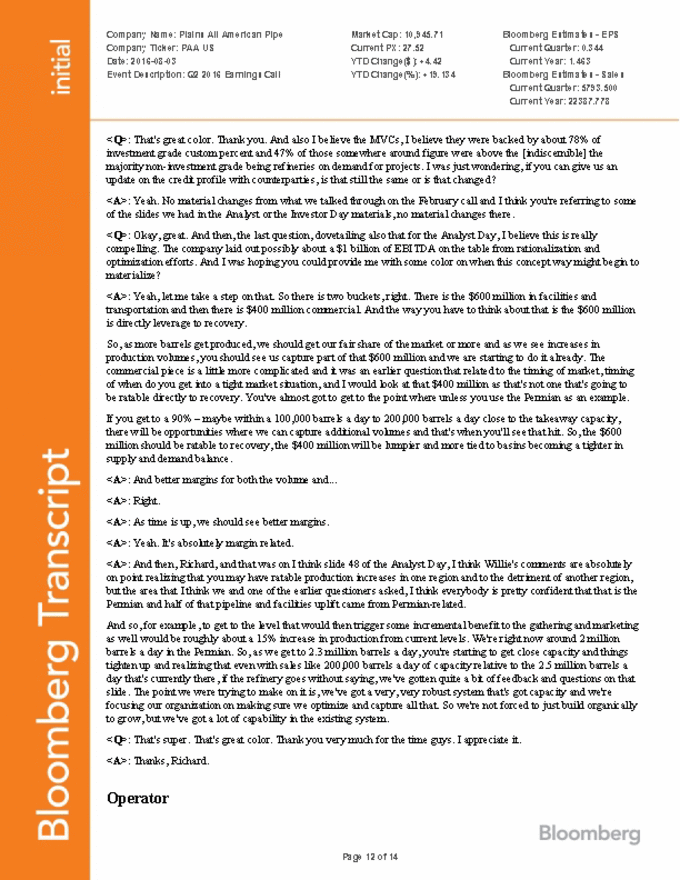
Company Name: Plains All American Pipe Company Ticker: PAA US Date: 2016-08-03 Event Description: Q2 2016 Earnings Call Market Cap: 10,945.71 Current PX: 27.52 YTD Change($): +4.42 YTD Change(%): +19.134 Bloomberg Estimates - EPS Current Quarter: 0.344 Current Year: 1.463 Bloomberg Estimates - Sales Current Quarter: 5793.500 Current Year: 22387.778 Thank you. [Operator Instructions] We have a question from the line of Patrick Wayne from Baird. Please go ahead. <Q>: Hey, good morning. You previously commented on the ability to maintain that one-times plus distribution coverage even in the that bearish scenario C or even worse. But today it sounds like scenario B is the most likely outcome based on the current dynamics. Can you touch on the leverage side of this outlook and perhaps weighing on the relative contributions of the drivers to reach the targeted 3.5 times to four 4 times ratio, whether it's between the distribution reset, equity, EBITDA growth and then to the extent the latter is a contingent on that production recovery. <A>: Yeah. I'll take a shot at it. Clearly, the most preferred and best alternative to de-lever is cash flow growth and we expect cash flow growth from the capital projects, the MBCs that will come on, as well as ultimately from an industry recovery, industry recovery is a little bit a timing wise, little bit outside of our control. Clearly, in the meantime, as we look at using proceeds from asset sales that is very significantly deleveraging as well. So really kind of a combination of all three of those, with one being the timing is a little bit more uncertain. I think in our scenario B, we didn't assume a meaningful industry recovery until basically mid-2017, so roughly about 12 months from now. But one of the other key points though is with the simplification, the IDR removal and arguably some un – removal of the uncertainty around our stock and what the distribution reset would be, equity is also a tool. And really what we're – we're not trying to say by X date, we're going to be at X level exactly. But we think the combination of really all four of those will really drive and see significant improvement in our leverage. And really probably on the last point, just to reiterate our commitment to seeing our leverage come down to maintain our investment grade ratings at both agencies, Moody's and S&P. So, again not a specific time that we're going to tell you, but really we see all four of those coming into play. <A>: Yeah. I would also say Patrick, that every move that we make from this point forward is going to be with the focusing on how do we make sure we're not stepping farther away from those credit metrics. So, for example, if we make an acquisition, but we're selling an asset, say for the same exact dollar amount, but the acquisition obviously is going to have a better multiple for us than the one that we sold in terms of benefiting our leverage, to the extent we make an acquisition and – or a capital expenditure, that it's not currently on the table, but is a proven thing for us do, you'd probably see us finance it with a little more equity than we would normally do on our 55, 45. So, it's – we're going to beat this thing with everything we've got in the artillery, but the commitment there is extremely strong to bring it back in within a reasonable time period and then build coverage on the distribution. And we think we can do all of that and still be very competitive with our peers with respect to large cap peers and the rich – adjusted risk profile to be an attractive investment for our equity holders. <Q>: Okay. That's very helpful. That's it from me. Thanks for the time. Operator Thank you. Our next question is from Justin Jenkins with Raymond James. Please go ahead. <Q - Justin Jenkins>: Hey, good morning, guys. I appreciate the color this morning. Most of mine have been asked and answered, but I guess I'll just follow-up real quick on the last comments you made. Looks like based on unit count guidance for Q4 2016 there is some decent ATM issuance planned. Can you guys just give us a sense on how opportunistic you plan to be with ATM in the back half of 2016 and into 2017? <A>: Yeah. I'll take a shot at that. We will look at it on an opportunistic basis, but I think what you're seeing there is the assumption of the shares being issued as a result of the simplification. <Q - Justin Jenkins>: Okay. When I do the math there, it looks like that is between 5 million units and 10 million units, just curious if there is a decent chuck of ATM in there and then maybe how we think about it in the 2017 on an ATM? <A>: Yeah. Like we said, we are assuming we'll take an opportunistic approach with equity, but the large chunk of what you're seeing is that, is the number of shares coming in from the simplification, but we have assumed some Page 13 of 14
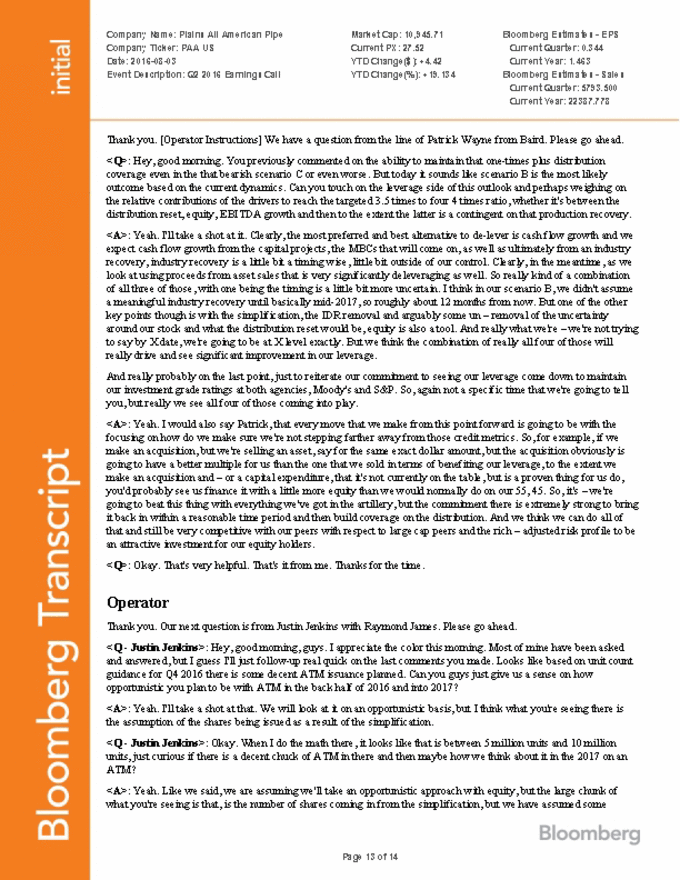
Company Name: Plains All American Pipe Company Ticker: PAA US Date: 2016-08-03 Event Description: Q2 2016 Earnings Call Market Cap: 10,945.71 Current PX: 27.52 YTD Change($): +4.42 YTD Change(%): +19.134 Bloomberg Estimates - EPS Current Quarter: 0.344 Current Year: 1.463 Bloomberg Estimates - Sales Current Quarter: 5793.500 Current Year: 22387.778 opportunistic usage of our ATM. <A>: To use your number, I mean 10 million units would be roughly 1.5% issuance. When you run it through the offset of the interest expense, it has a fairly meaningful on deleveraging, matter impact of DCF per unit. <Q - Justin Jenkins>: Okay. No, that's perfect. I appreciate the color guys. <A>: Thank you. Operator Thank you. And at this time there are no further questions in queue. Please continue. Greg L. Armstrong I want to thank again everybody for participating in today's call, and we look forward to updating you on our call in November. Operator Thank you. And that does conclude our conference for today. Thank you for your participation and for using AT&T Executive Teleconference. You may now disconnect. This transcript may not be 100 percent accurate and may contain misspellings and other inaccuracies. This transcript is provided "as is", without express or implied warranties of any kind. Bloomberg retains all rights to this transcript and provides it solely for your personal, non-commercial use. Bloomberg, its suppliers and third-party agents shall have no liability for errors in this transcript or for lost profits, losses, or direct, indirect, incidental, consequential, special or punitive damages in connection with the furnishing, performance or use of such transcript. Neither the information nor any opinion expressed in this transcript constitutes a solicitation of the purchase or sale of securities or commodities. Any opinion expressed in the transcript does not necessarily reflect the views of Bloomberg LP. © COPYRIGHT 2016, BLOOMBERG LP. All rights reserved. Any reproduction, redistribution or retransmission is expressly prohibited. Page 14 of 14
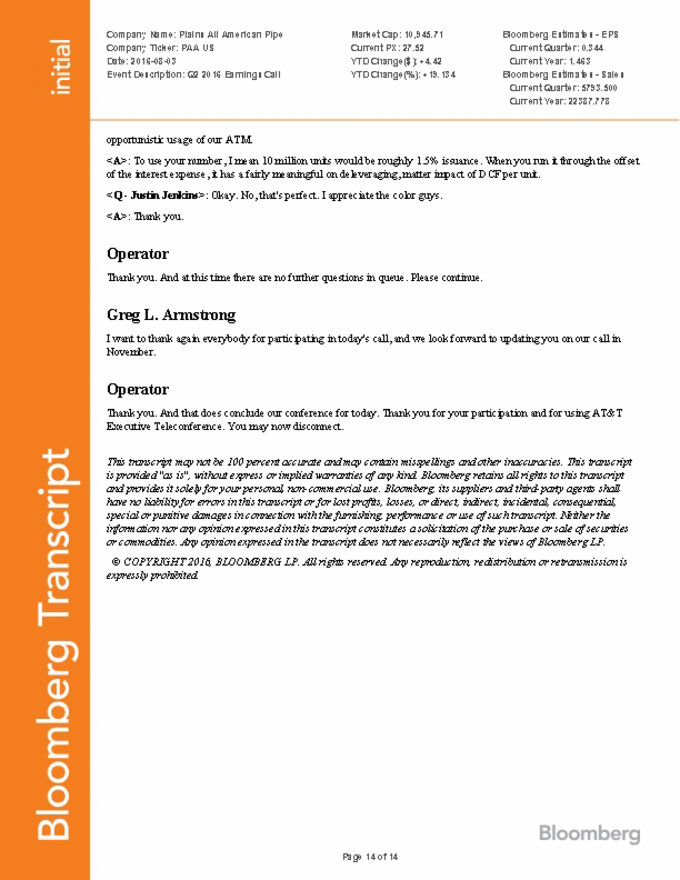
Second-Quarter 2016 Conference Call Houston, TX • August 3, 2016
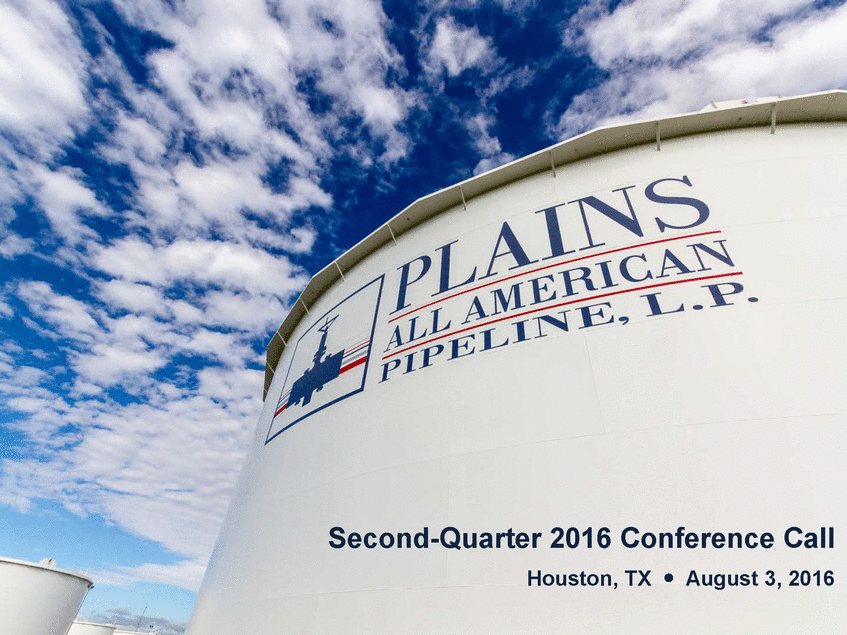
Forward-Looking Statements & Non-GAAP Financial Measures Disclosure This presentation contains forward-looking statements, including, in particular, statements about the plans, strategies and objectives for future operations of Plains All American Pipeline, L.P. (“PAA”) and Plains GP Holdings, L.P. (“PAGP”). These forward-looking statements are based on PAA’s current views with respect to future events, based on what we believe to be reasonable assumptions. PAA and PAGP can give no assurance that future results or outcomes will be achieved. Important factors, some of which may be beyond PAA’s and PAGP’s control, that could cause actual results or outcomes to differ materially from the results or outcomes anticipated in the forward-looking statements are disclosed in PAA’s and PAGP’s respective filings with the Securities and Exchange Commission. This presentation also contains non-GAAP financial measures relating to PAA, such as adjusted EBITDA. A reconciliation of these measures to the most directly comparable GAAP measures is available in the Investor Relations section of PAA’s and PAGP’s website at www.plainsallamerican.com, select “PAA” or “PAGP,” navigate to the “Financial Information” tab, then click on “Non-GAAP Reconciliations.” www.plainsallamerican.com NYSE: PAA & PAGP 2
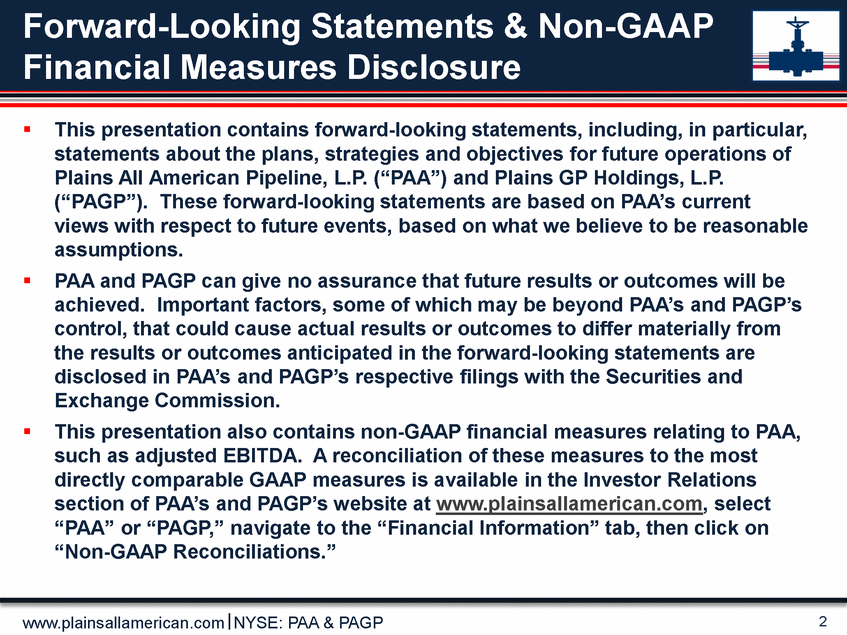
Summary of Second-Quarter 2016 Results Exceeded mid-point of adjusted EBITDA guidance by ~$21mm, or 5% by solid performance in our fee-based Transportation and Facilities segments----Driven Diluted Unit $461 $440 (G) 2Q 2015 2Q 2016 (G) 2Q 2016 2Q 2015 2Q 2016 (G) 2Q 2016 ($0.12) (G) Midpoint guidance furnished via Form 8-K on May 4, 2016. (1) Distribution coverage is calculated by dividing the implied distributable cash flow for a given period by the distributions paid to both common unitholders and the general partner in that period. 2Q16(G) implied distributable cash flow utilizes implied distributable cash flow furnished via Form 8-K on May 4, 2016. For purposes of the 2Q16 distribution coverage ratio above, preferred unit distributions paid in kind are not included in distributions paid. www.plainsallamerican.com NYSE: PAA & PAGP 3 Adjusted EBITDA (in millions) $486 Implied Distributable Cash Flow and Distribution Coverage(1) $285 Adjusted Net Income / $0.27 $0.02 2Q 2015 2Q 2016 2Q 2016 (in millions) $307$314 73%66%73%
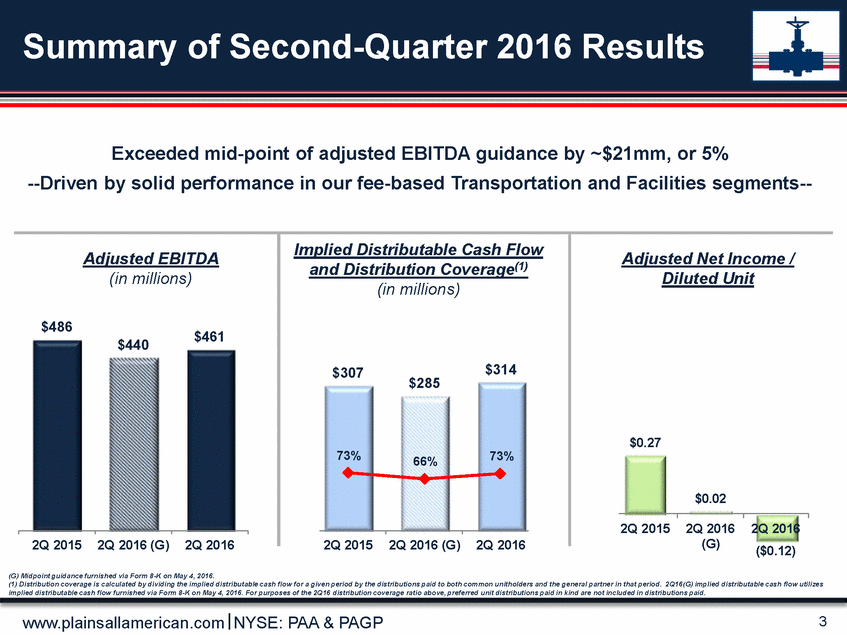
PAA 2Q16 Segment Results Overview (Commentary Specific to 2Q 2016 Performance vs. 2Q 2016 Guidance) Adjusted Segment Profit (in millions) Transportation Facilities Higher throughput at several facilities Higher contracted capacity at several West Coast terminals Lower maintenance and integrity expense (primarily timing related) Supply & Logistics Higher volumes on certain higher tariff pipelines, such as Line 2000 and Canadian NGL lines • •Results in line with guidance • • • $261 $256 $252 $161 $146 $148 $84 $41 $39 2Q 2015 2Q 2016 (G) 2Q 2016 2Q 2015 2Q 2016 (G) 2Q 2016 2Q 2015 2Q 2016 (G) 2Q 2016 Volumes & Adjusted Segment Profit / Barrel (Thousands of Barrels / Day) (Millions of BOE / Month) (Thousands of Barrels / Day) 1,125 129 128 126 1,070 1,066 2Q 2015 2Q 2016 (G) 2Q 2016 2Q 2015 2Q 2016 (G) 2Q 2016 2Q 2015 2Q 2016 (G) 2Q 2016 (G) Midpoint guidance furnished via Form 8-K on May 4, 2016. www.plainsallamerican.com NYSE: PAA & PAGP 4 4,529 4,770 4,781 $0.62$0.58$0.60 $0.39$0.38$0.42 $0.82 $0.42$0.41
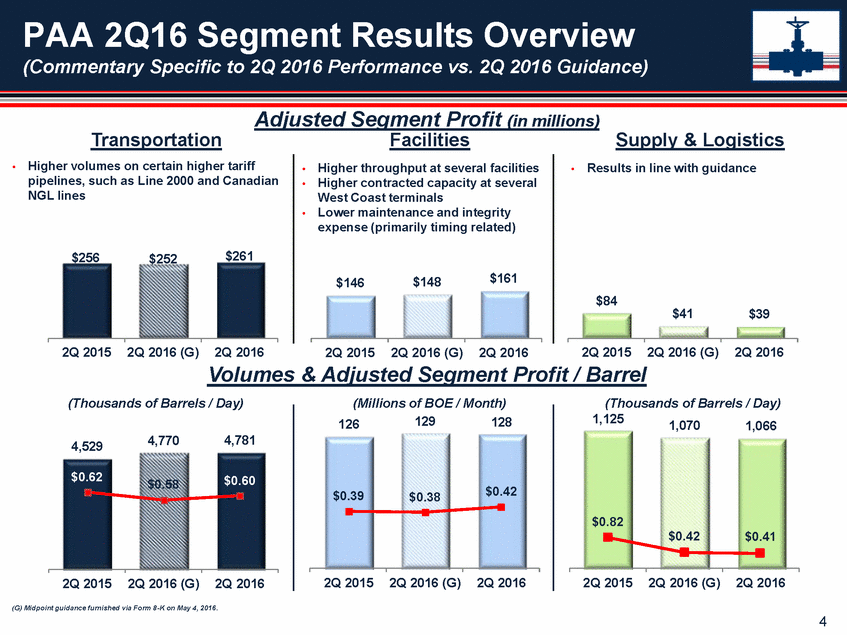
2016 Major Capital Projects PAA is in the process of completing a multi-year, multi-billion dollar capital expansion program (no material capital commitments beyond 2017) Contractual In Service (G) Based on guidance furnished via Form 8-K on August 2, 2016 www.plainsallamerican.com NYSE: PAA & PAGP 5 2016 (G) Expansion Capital (in millions)MVC / Support Pipeline Strategy 2016(G) Timings Red River PipelineYesDemand Pull$3104Q16 Fort Sask Facility ProjectsYes-1902016 & 2017 Permian Basin Area ProjectsYesSupply Push185Present - 4Q16 Diamond PipelineYesDemand Pull1654Q17 Saddlehorn PipelineYesSupply Push1253Q16 Cushing Terminal ExpansionsYes-60Present - 2Q17 St. James Terminal ExpansionsYes-45Present - 2Q17 Caddo PipelineYesDemand Pull351Q17 Cactus PipelineYesSupply Push20Present - 4Q16 Eagle Ford JV ProjectYesSupply Push20Present - 4Q18 Other Projects-270FY 2016 - 2017 $1,425
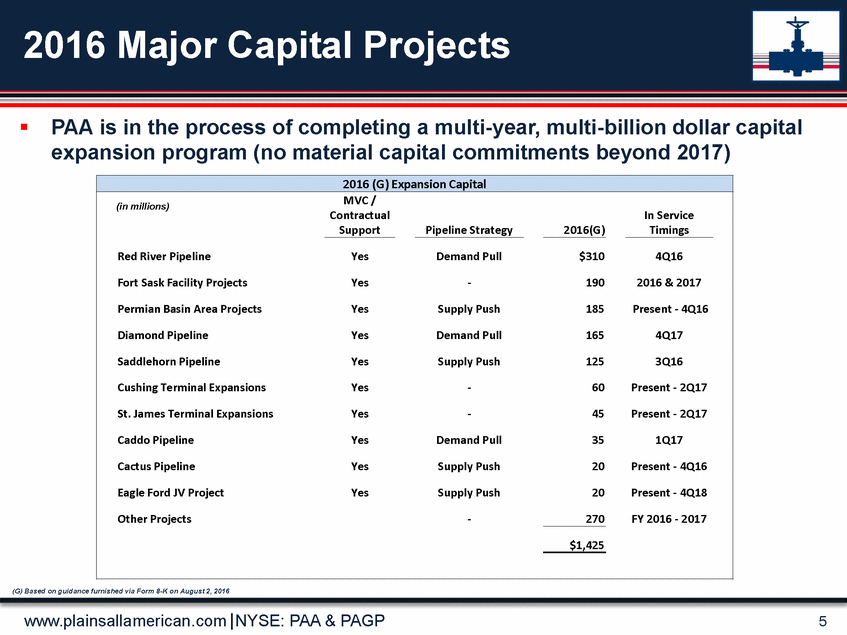
Update On Strategic Divestitures/Acquisitions Anticipate proceeds near the high end of our $500-$600mm guidance range for 2016 from non-core asset sales Does not include proceeds from potential sale of Richmond or Martinez terminals Closed two transactions for total net proceeds of ~$130mm 50% interest in Cheyenne Pipeline LLC to strategic partner, Holly Energy Partners (Closed June 2016) Gulf Coast CAM pipeline system (Closed July 2016) ~$480mm Year-To-Date in total net sales proceeds Evaluating possibility for additional non-core asset sales and/or sale of partial interest to strategic partners Canadian NGL Acquisition: satisfied regulatory closing conditions, scheduled to close within the next week or so Note: All proceeds are approximate and net of closing costs www.plainsallamerican.com NYSE: PAA & PAGP 6
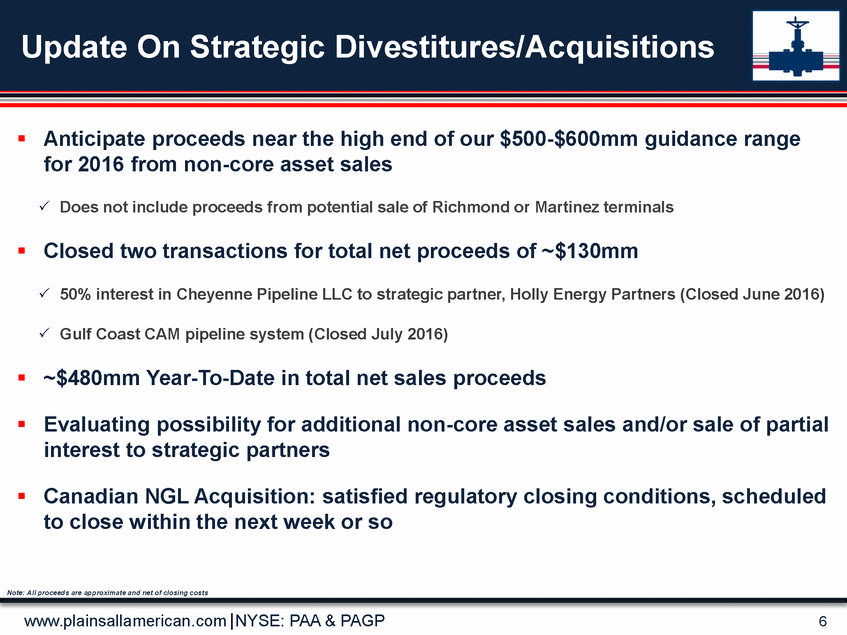
PAA 3Q16 Segment Guidance Overview (Commentary Specific to 3Q 2016 Guidance vs. 2Q 2016 Performance) Adjusted Segment Profit (in millions) Transportation Volume growth in gathering systems (Permian & Oklahoma), offset by sale of Gulf Coast CAM pipeline and projected shortfall in MVC volumes Segment profit per barrel increase driven by anticipated Q3 MVC billing Facilities Increased volumes due to acquisition of Canadian NGL assets Supply & Logistics Anticipate increased U.S. crude oil lease gathering volumes Lower lease gathering margins and less favorable crude oil market conditions offset by stronger NGL sales Increased volumes at Cushing and James St. Less favorable W. Coast terminals; higher operating expenses, primarily timing of maintenance and integrity $291 $261 $253 $161 $148 $147 $95 $39 $38 3Q 2015 2Q 2016 3Q 2016 (G) 3Q 2015 2Q 2016 3Q 2016 (G) 3Q 2015 2Q 2016 3Q 2016 (G) Volumes & Adjusted Segment Profit / Barrel (Thousands of Barrels / Day) (Millions of BOE / Month) (Thousands of Barrels / Day) 130 1,114 128 1,090 126 1,066 4,781 4,630 $0.68 4,545 $0.60 $0.61 $0.42 $0.39 $0.38 $0.92 $0.41 $0.37 3Q 2015 2Q 2016 3Q 2016 (G) 3Q 2015 2Q 2016 3Q 2016 (G) 3Q 2015 2Q 2016 3Q 2016 (G) (G) Midpoint guidance furnished via Form 8-K on August 2, 2016. Adjusted segment profit per barrel amounts above include the MVC selected item. www.plainsallamerican.com NYSE: PAA & PAGP 7
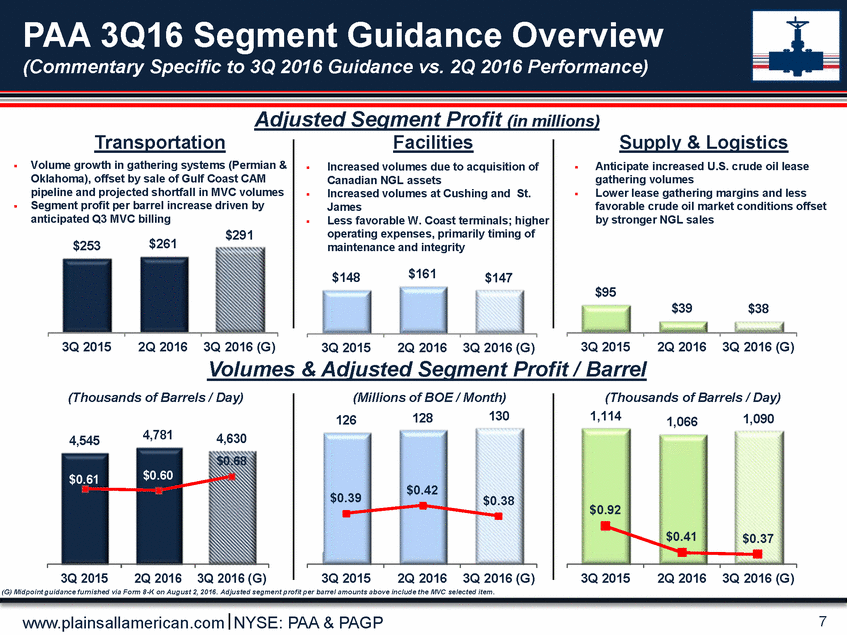
PAA Guidance Snapshot (Furnished via Form 8-K on August 2, 2016) (in millions) 3Q16 Midpoint Guidance Full-year 2016 Midpoint Guidance Illustrative 2016 Adjusted EBITDA by Quarter --Reflects Seasonality of NGL Business--Pro forma for the simplification and distribution reset, cash coverage of 1.03x and 1.05x for second half and full year of 2016, respectively (1)(2) $2,175 S&L S&L S&L S&L $1,484 Trans & Facilities Trans & Facilities Trans & Facilities Trans & Facilities $475 $305 Implied Distributable Cash Flow(1) Adjusted EBITDA 1Q16 2Q16 3Q16 4Q16 (1) For purposes of the distribution coverage ratios above, preferred unit distributions paid in kind are not included in distributions paid. (2) Reflects an anticipated PAA quarterly distribution of $0.55 payable in November. Applying the $0.55 quarterly distribution on a pro forma basis results in a 2016 distribution coverage of 1.05x. Actual coverage for 3Q16 and full-year 2016 is expected to be ~0.70x and ~0.92x, respectively. Note: Adjusted results exclude the impact of Selected Items Impacting Comparability (SIIC). Please visit our website at www.plainsallamerican.com (Investor Relations and Financial Information sections) for a reconciliation of EBITDA and adjusted results. www.plainsallamerican.com NYSE: PAA & PAGP 8
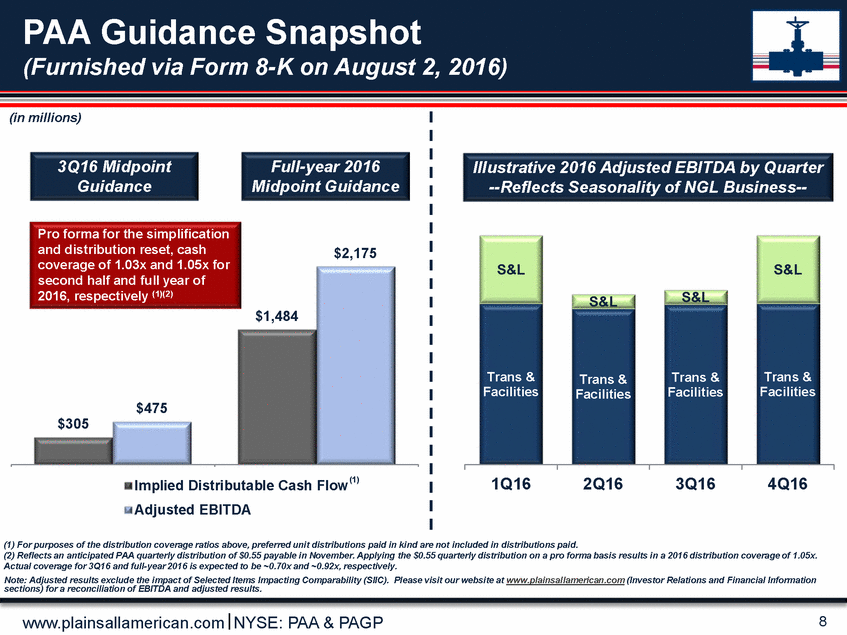
PAA & PAGP Capitalization & Liquidity As of June 30, 2016 Simplification Transaction Pro Forma PAA Capitalization PAA will assume 100% of the GP debt of $593 million PAA partners’ capital decreases by amount of debt assumption; equity-for-equity exchange does not result in a change in partners’ capital ($ millions) Pro Forma 6/30/2016 (4) Adj. 6/30/2016 Long-term Debt Partners' Capital $9,486 8,970 $608 (608) $10,094 8,362 Total Book Capitalization $18,456 $0 $18,456 (1) Includes short-term debt. (2) PAA’s interest expense represents the full-year 2016 guidance furnished via form 8-K on 08/02/16. PAGP’s interest expense for the six months ended 06/30/16 has been annualized for purposes of the 06/30/16 calculation. (3)wPAwA awnd P.ApGlPamientricsaare lclaalcumlateed ursing aPAnA’s.cfulol-ymear 201N6 aYdjusStedEEB:ITPDAAguAidan&ce fuPrniAsheGd viPa Form 8-K on 8/2/16. 9 (4) Includes approximately $15 million in transaction costs. Capitalization (in millions)PA A Long-term Debt$9,486 Partners' Capital $8,970 Total Book Capitalization$18,456 PAGP $10,077 $10,289 $20,366 Credit Stats & Liquidity Target Long-term Debt / Total Book Cap51%~50% Total Debt / Total Book Cap (1) 55%~60% Adj. EBITDA / Interest (2)(3) 4.7x>3.3x Long-term Debt / Adj. EBITDA (3) 4.4x~3.5x-4.0x Committed Liquidity$2.9 bn 49% 53% 4.7x 4.6x $3.0 bn
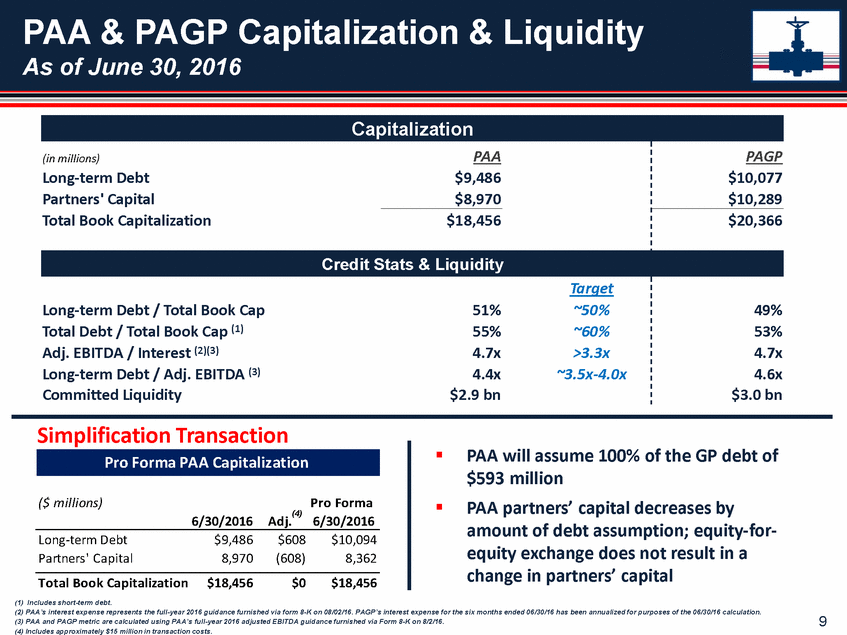
Second-Quarter 2016 Conference Call Overview Significant events since May 5th earnings conference call: 2016 Investor Day – updated crude oil outlook and discussed PAA’s positioning relative to current and expected environment Announced simplification transaction and affirmed 2016 guidance Announced intent to reset distribution, beginning with quarterly distribution payable in November, achieving pro forma coverage of greater than 1:1 2Q16: PAA exceeded mid-point adjusted EBITDA guidance by ~$21mm, or 5%, driven by Transportation & Facilities segments Continuing to progress 2016 capital program underpinned by either MVCs or similar contractual commitments Saddlehorn Pipeline: completed Platteville, CO to Cushing, OK segment Asset Sales & Acquisition Update Targeting $500mm - $600mm in asset sales for 2016 Closed two transactions for ~$130mm (Gulf Coast CAM Pipeline; 50% of Cheyenne Pipeline to strategic partner, Holly Energy Partners) Canadian Empress Acquisition – regulatory approval received and closing scheduled this week Well positioned to achieve targeted distribution coverage of 1.15x and debt to adjusted EBITDA ratio of 3.5 – 4.0x over time Note: Asset sales proceeds are approximate and net of closing costs www.plainsallamerican.com NYSE: PAA & PAGP 10
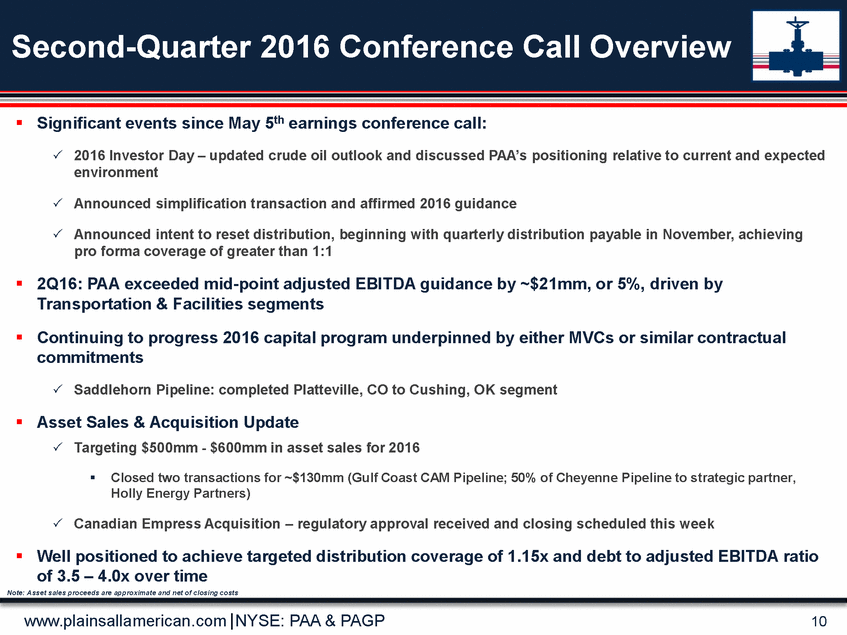
www.plainsallamerican.com NYSE: PAA & PAGP 11 Appendix
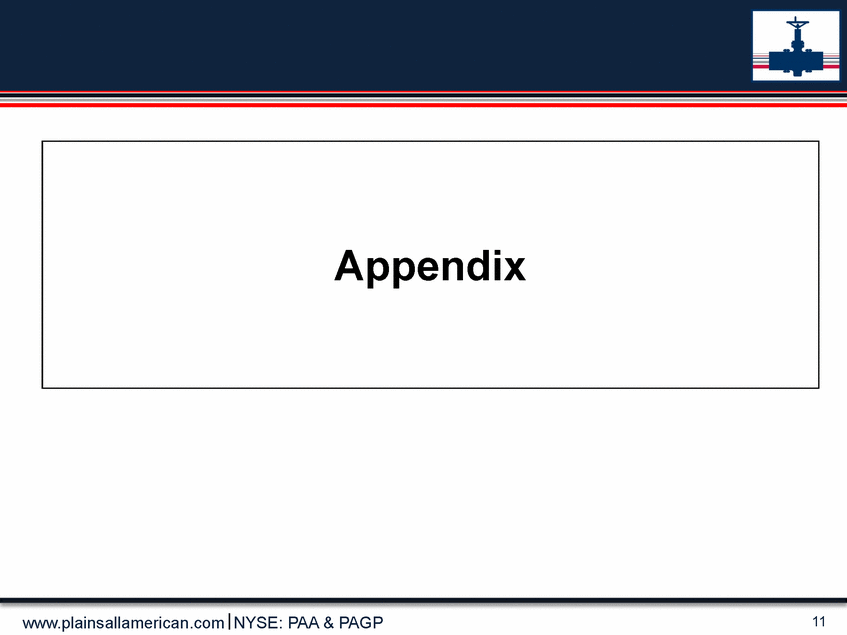
Condensed Consolidating Holdings (PAGP) Balance Sheet of Plains GP PLAINS GP HOLDINGS AND SUB SIDIARIES FINANCIAL SUMMARY (unaudited) CONDENSED CONSOLIDATING B ALANCE SHEET DATA (in millions) June 30, 2016 De ce mbe r 31, 2015 (1) Rep resents the aggregate consolidating adjustments necessary to p roduce consolidated financial statements for PAGP. www.plainsallamerican.com NYSE: PAA & PAGP 12 Cons olidating PAA Adjus tme nts (1)PAGP Cons olidating PAA Adjus tme nts (2)PAGP ASSETS Current assets $ 3,603 $ 2 $ 3,605 $ 2,969 $ 3 $ 2,972 Property and equipment, net 13,598 19 13,617 13,474 19 13,493 Goodwill 2,396 - 2,396 2,405 - 2,405 Investments in unconsolidated entities 2,161 - 2,161 2,027 - 2,027 Deferred tax asset - 1,893 1,893 - 1,835 1,835 Linefill and base gas 902 - 902 898 - 898 Long-term inventory 184 - 184 129 - 129 Other long-term assets, net 319 (2) 317 386 (3) 383 Total assets $ 23,163 $ 1,912 $ 25,075 $ 22,288 $ 1,854 $ 24,142 LIAB ILITIES AND PARTNERS' CAPITAL Current liabilities $ 4,029 $ 2 $ 4,031 $ 3,407 $ 2 $ 3,409 Senior notes, net of unamortized discounts and debt issuance costs 9,128 - 9,128 9,698 - 9,698 Other long-term debt, net of unamortized debt issuance costs 358 591 949 677 557 1,234 Other long-term liabilities and deferred credits 678 - 678 567 - 567 Total liabilities 14,193 593 14,786 14,349 559 14,908 Partners' capital excluding noncontrolling interests 8,912 (7,110) 1,802 7,881 (6,119) 1,762 Noncontrolling interests 58 8,429 8,487 58 7,414 7,472 Total partners' capital 8,970 1,319 10,289 7,939 1,295 9,234 Total liabilities and partners' capital $ 23,163 $ 1,912 $ 25,075 $ 22,288 $ 1,854 $ 24,142
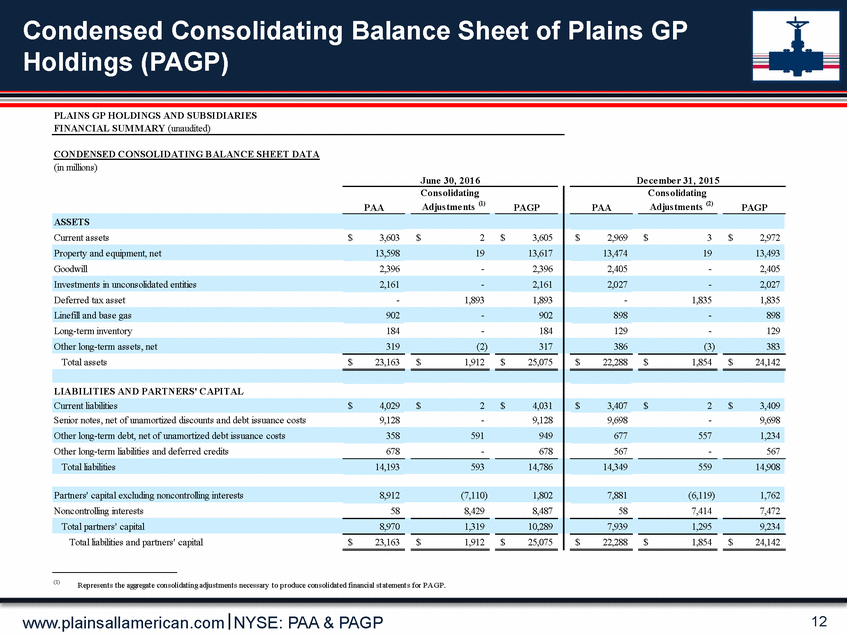
Summary of Plains GP Holdings (PAGP) Distributions from PAA’s General Partner (“AAP”) PLAINS GP HOLDINGS AND SUB SIDIARIES DISTRIB UTION SUMMARY (unaudited) Q2 2016 PAGP DISTRIB UTION SUMM ARY (in millions, except per unit and per share data) Q2 2016 (1) GP Distribution/Common Unit $ 0.3885 Less: IDR Reduction (5) Less: Debt Service (3) Cash Available for Distribution by AAP $ 151 Dis tributions to AAP Partne rs PAGP (41% economic interest) 62 PAGP Class A Shares Outstanding at 7/29/16 267 (1) Amounts may not recalculate due to rounding. Plains AAP, L.P. ("AAP") is the general p artner of PAA. (2) www.plainsallamerican.com NYSE: PAA & PAGP 13 PAGP Distribution/Class A Share$0.231 Distribution to PAGP Investors$62 Total distributions to AAP Partners$151 Direct AAP Owners & AAP Management (59% economic interest)$89 Less: G&A Expense(1) Net Distribution from PAA to AAP (2) $155 Gross GP Distribution$160 PAA Common Units Outstanding at 7/29/16398 Total Distribution/Common Unit$1.0885 PAA Distribution/Common Unit$0.7000
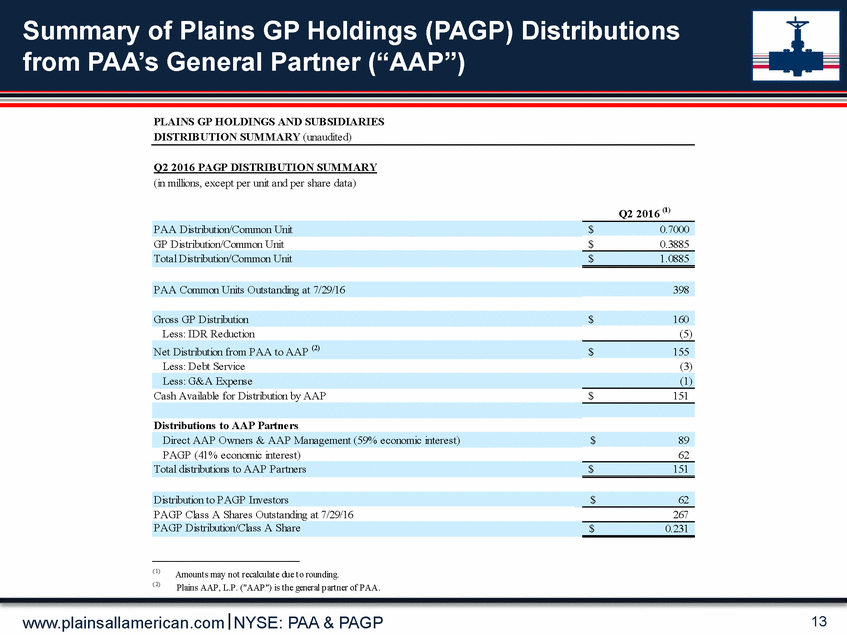
Additional Information and Where to Find It
The Simplification Transaction will be submitted to the shareholders of PAGP for their consideration, and PAGP will file with the SEC a proxy statement to be used by PAGP to solicit the required approval of its shareholders in connection with the Simplification Transaction. PAGP also plans to file other documents with the SEC regarding the proposed Simplification Transaction. INVESTORS AND SECURITY HOLDERS OF PAGP ARE URGED TO READ THE PROXY STATEMENT AND OTHER RELEVANT DOCUMENTS THAT WILL BE FILED WITH THE SEC CAREFULLY AND IN THEIR ENTIRETY WHEN THEY BECOME AVAILABLE BECAUSE THEY WILL CONTAIN IMPORTANT INFORMATION ABOUT THE SIMPLIFICATION TRANSACTION. Security holders may obtain free copies of the proxy statement and other documents containing important information about PAGP, once such documents are filed with the SEC, through the website maintained by the SEC at http://www.sec.gov. Copies of the documents filed with the SEC by PAGP will be available free of charge on PAGP’s website at ir.pagp.com or by contacting PAGP’s Investor Relations Department at (866) 809-1291.
Participants in the Solicitation
PAGP and the directors and executive officers of its general partner (“PAGP GP”), and Plains All American Pipeline, L.P. (“PAA”) and the directors and executive officers of the general partner of the sole member of its general partner, Plains All American GP LLC (“GP LLC”), may be deemed to be “participants” in the solicitation of proxies from PAGP’s shareholders in connection with the Simplification Transaction. Information about the directors and executive officers of PAGP GP is set forth in PAGP’s Annual Report on Form 10-K and information about the directors and executive officers of GP LLC is set forth in PAA’s Annual Report on Form 10-K, which were each filed with the SEC on February 25, 2016, and PAGP’s and PAA’s subsequent Quarterly Reports on Form 10-Q. These documents can be obtained free of charge from the sources indicated above. Other information regarding the participants in the proxy solicitation and a description of their direct and indirect interests, by security holdings or otherwise, will be contained in the proxy statement that PAGP intends to file with the SEC.
Serious News for Serious Traders! Try StreetInsider.com Premium Free!
You May Also Be Interested In
- Century Next Financial Corporation Reports Record 1st Quarter 2024 Results
- Vext Announces Delay of Annual Filings and Postponement of Conference Call
- UGE Announces Financial Results Release Date and Webinar
Create E-mail Alert Related Categories
SEC FilingsSign up for StreetInsider Free!
Receive full access to all new and archived articles, unlimited portfolio tracking, e-mail alerts, custom newswires and RSS feeds - and more!



 Tweet
Tweet Share
Share